Get the Most out of Your Tea with Chinese Teaware
At Hey China we know the perfect cup of tea isn’t just about the leaves; it’s also about the teaware you use to make and drink it. We have a beautiful range of authentic Chinese teaware to elevate your tea experience and bring a bit of elegance to your tea time. Whether you’re a tea aficionado or just starting out on your Chinese tea journey, we have everything you need to brew and enjoy tea the traditional Chinese way.
Our Chinese Tea Sets
Our Chinese teaware includes everything you need to set up your perfect tea at home. Each piece is made with love and care, reflecting the rich history of Chinese tea.
- Tea Cups: Our Chinese tea cups are designed to match the flavour of your favourite teas. From simple to intricate designs, our tea cups are for any tea occasion.
- Tea Pots: The tea pot is the heart of any tea ceremony. Our Chinese tea pots are made from high quality materials like Yixing clay and porcelain so every brew is infused with the full flavour of the tea leaves.
- Cast Iron: Our cast iron teapots retain heat and preserve the flavor of tea, available in various designs and colors, making them exquisite serving options for multiple servings.
- Tea Trays: A tea tray is essential for serving tea, catching spills and displaying your teaware beautifully. Our Chinese tea trays include traditional wooden trays and modern designs, all to enhance your tea time.
- Tea Tools: For the true tea lover, our Chinese tea tools include tea accessories like scoops, spoons, whisks, strainers, and infusers. These tools are functional and add authenticity to your tea ritual.
- Matcha Bowl: An essential item for creating an authentic and enjoyable matcha experience.
- Matcha Whisk: A quality bamboo chasen is crucial for achieving the right froth and flavor in your matcha tea.
- Tea Sets: Our Chinese tea sets make a great gift or addition to your own collection. Complete with matching tea cups, tea pots and accessories, our tea sets are available in many styles to suit everyone.
- Tea Storage: Proper storage is key to keeping your tea fresh. Our Chinese tea storage solutions include beautifully crafted containers that protect your tea from light, air and moisture and add a decorative touch to your kitchen or tea room.
Why Chinese Teaware from Hey China?
Authenticity
All our Chinese teaware is made the traditional way so each piece is not only beautiful but also true to the history and culture of Chinese tea. Whether you’re choosing a simple tea cup or a full tea set, you can be sure you’re getting an authentic product made by skilled craftsmen.
Elevate Your Tea Drinking Experience
The right teaware can make all the difference to your tea drinking experience. Our Chinese tea pots, cups and accessories are designed to bring out the best in your tea so you can fully appreciate the flavour and aroma. Whether you’re having a cup on your own or with friends, our teaware makes every tea time special.
Variety of Premium Loose Leaf Teas
Hey China has a wide range of Chinese teaware to suit everyone. Whether you’re looking for a traditional tea pot or a modern tea tray, we have something for you. Browse our range and find your perfect teaware to match your tea collection.
Gift Giving
Our Chinese teaware also makes a great gift for any tea enthusiast. Whether it’s a special occasion or just to share the love of tea, our beautifully crafted tea sets and accessories will impress.
- 121 Tea Cups
- 34 Tea Pots
- 23 Tea Trays
- 8 Tea Tools
- 22 Tea Sets
- 1 Tea Storage
Product Filters
Filter by Category
Filter by Pu-erh Type
Filter by Type
Filter by Taste
Filter by Origin
Filter by Caffeine Level
Filter by Leaf Form
Filter by Brand
Filter by Colour
Filter by Material
Filter by Number of Pieces
Filter by Colour
Filter by Material
Filter by Size
Filter by Colour
Filter by Material
Filter by Size
Filter by Colour
Filter by Material
Filter by Size
194 Products
-
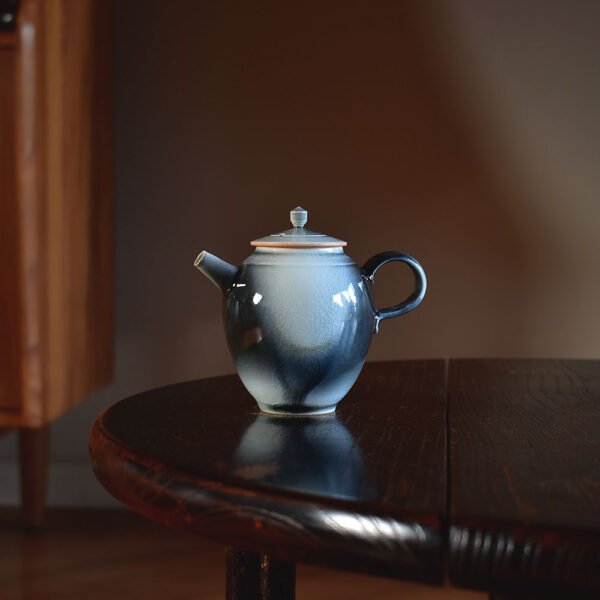
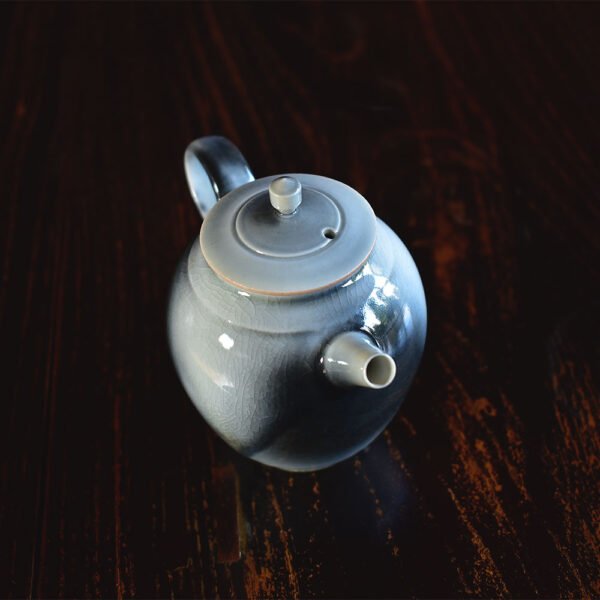 $143.99
$143.99This small teapot is made by both kiln-fired glaze variations and cracked glaze craft. Because kiln alteration techniques enable an exciting and dynamic way to create different red colour glazes on this teacup, each teacup is unique and made by hand, with no two being exactly alike. The phenomenon of crystal formation is caused by a kiln altered in a cup, commonly known as “crystal flowers”.
Besides that, the unique cracked glaze technique used creates beautiful patterns on the cup’s surface. Over time as it is soaked with tea soup, and the resulting variations in the pattern make each piece truly outstanding and add more enjoyment to the tea-drinking experience.
Attention:
- Kiln-fired glaze variations are often unpredictable and can result in a wide range of colours from a single firing.
- The porosity of ceramics varies depending on the materials used, the recipe, the pressure applied, the duration of pressure, the thickness of the body, the firing temperature, and the duration of firing. Generally, the finer the porcelain, the smaller the pores, while the coarser the pottery, the larger the pores.
- Since porcelain is made from clay, the amount of iron spots present in the clay varies depending on the mineral content of the soil. These iron spots are harmless and do not affect the use of the porcelain. Removing them would require the use of chemical materials, which can be damaging to high-quality porcelain.
- Handmade products are not perfect, and each piece can have differences in size, shape, colour, and other aspects.
-
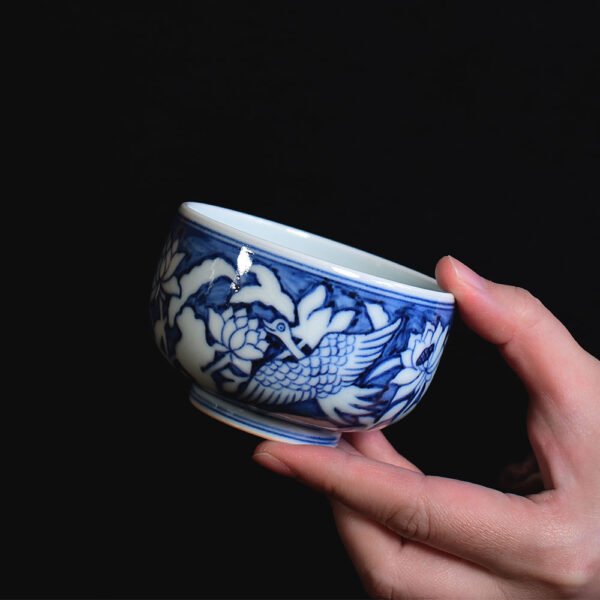
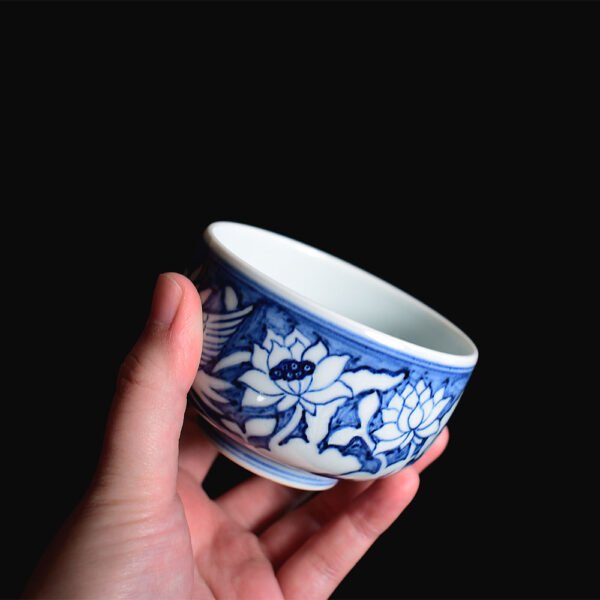 Out of Stock
$439.99
Out of Stock
$439.99This arhat teacup is made in the style of the Yuan dynasty blue and white porcelain, completely handmade and hand painted. The pattern of “一鹭莲科” or “一路连科” in Chinese culture is derived from the beautiful combination of the heron and lotus leaves. As “鹭” (heron) and “路” (path/road) have the same pronunciation, and “莲” (lotus) sounds like “连” (successive/continuous), the name “一路连科” is a play on words that conveys the beautiful meaning of the pattern. In ancient times, successive successful candidates in the imperial examinations were called “连科,” and “一路连科” is a good wish for students to have a smooth career path and achieve success step by step.
This teacup has a thick body and uses the Su Ma Li Qing glaze material (a kind of blue pigment) which reveals a unique charm of the past era. The entire production process is completed by hand, and every detail has been carefully designed and polished, giving this teacup a unique artistic charm.
-
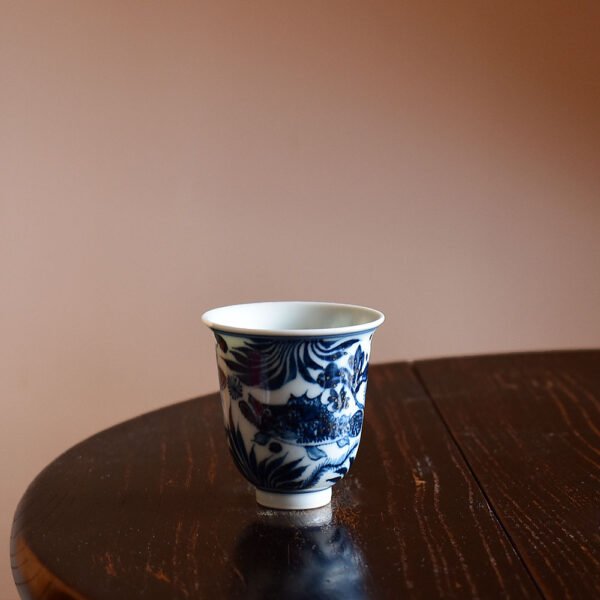
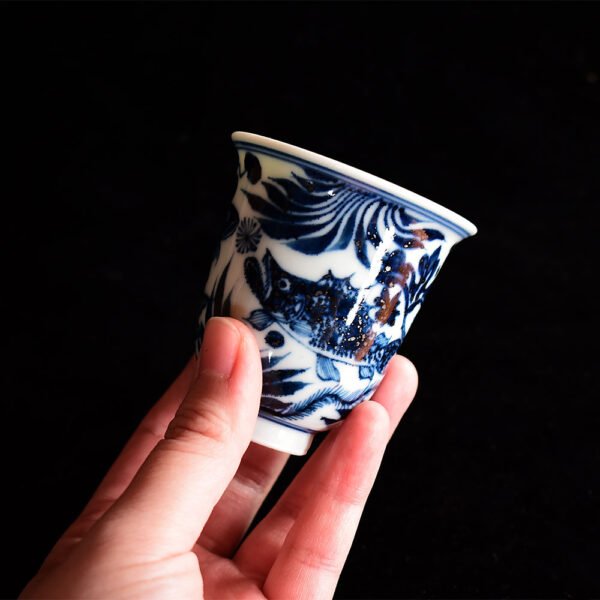 Out of Stock
$199.99
Out of Stock
$199.99This teacup is made in the style of the Yuan dynasty blue and white porcelain, completely handmade and hand painted. The blue and white fish & seaweed pattern is vivid, showcasing ancient cultural and aesthetic values, allowing people to immerse themselves in a beautiful artistic atmosphere while enjoying their tea.
The special pattern of this teacup is fish and seaweed. Since ancient times, fish and seaweed motifs have been traditional decorative patterns in ceramics, representing auspiciousness and carrying rich cultural and aesthetic meanings. The homophonic association between fish and the Chinese word for “surplus” (yu) makes fish a symbol of abundance and wealth. Fish motifs are often used to convey the meaning of “abundance and surplus,” “prosperity year after year” (as the pronunciation of fish is similar to that of “surplus” in Chinese), and “auspicious celebrations and abundance.” The fish and seaweed motifs typically feature fish as the central element, with additional decorations such as water plants, forming a variety of decorative patterns. The depiction of four swimming fish in the artwork symbolizes the concept of “surplus in all four seasons,” representing a year-round surplus, which carries a highly positive connotation. Such motifs are not only favoured by the royal court but also beloved by people from all walks of life as auspicious decorations. The flexible composition, auspicious symbolism, and abundant variations of fish and seaweed motifs have made them timeless classics throughout different eras.
For Yuan blue and white porcelain refers to the blue and white porcelain produced during the Yuan dynasty (1271-1368) in China. The Yuan dynasty was an important period in the history of Chinese porcelain and one of the peaks of Chinese porcelain art. As one of the representatives of that era, Yuan blue and white porcelain exhibited unique artistic styles and technical levels. The characteristic of Yuan blue and white is the use of cobalt blue pigment for painting, which is made of cobalt oxide. After firing, the colour is bright and rich, with an extremely high decorative effect. Yuan blue and white porcelain has various shapes, thick and heavy, concise, and fluent lines, and stable and solemn shapes, all made exquisitely.
The evolution of Yuan blue and white is based on the foundation of the Tang and Song celadon. Firstly, the glaze colour was improved and innovated. Unique white glaze, eggshell glaze and blue-white glaze were invented to make the glaze crystal clear. Cobalt pigment was imported for glaze colouring. Or using pigment made from domestic materials.
The formation of tin spots on Yuan blue and white is due to the high content of iron elements in local parts of the blue pigment. After reaching saturation in the high-temperature glaze solution and cooling down, the iron elements in the supersaturated part start to precipitate. If the iron content of the blue pigment is higher and the cooling rate is appropriate, tin spots are more likely to appear on the surface of the ware.
In addition to firing and materials, the formation of tin spots also involves the factor of glaze material. During the painting process, tin spots can also be formed due to the accumulation of blue pigment. Tin spots are more likely to appear on the surface of the ware at the intersections and the starting and ending points of brushstrokes. The formation of tin spots can be said to be a natural creation or an artificial decoration.
This teacup has a thick body and uses the Su Ma Li Qing glaze material (a kind of blue pigment), with a heavy sense of tin spots, revealing a unique charm of the past era. The entire production process is completed by hand, and every detail has been carefully designed and polished, giving this teacup a unique artistic charm. The blue and white fish & seaweed pattern is vivid, showcasing ancient cultural and aesthetic values, allowing people to immerse themselves in a beautiful artistic atmosphere while enjoying their tea.
-
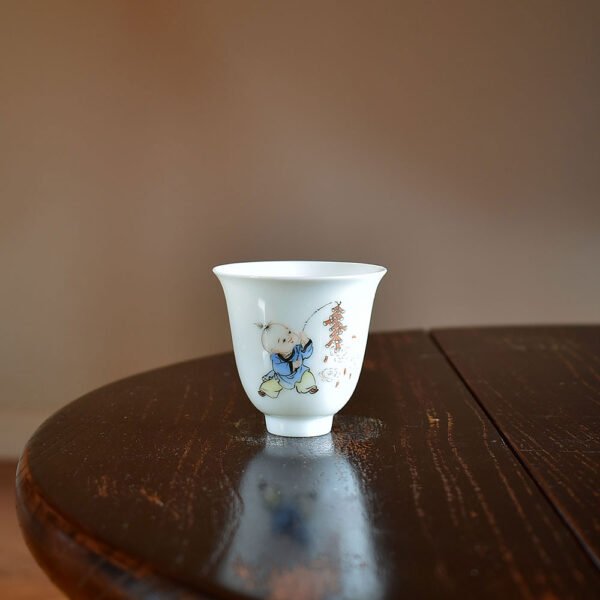
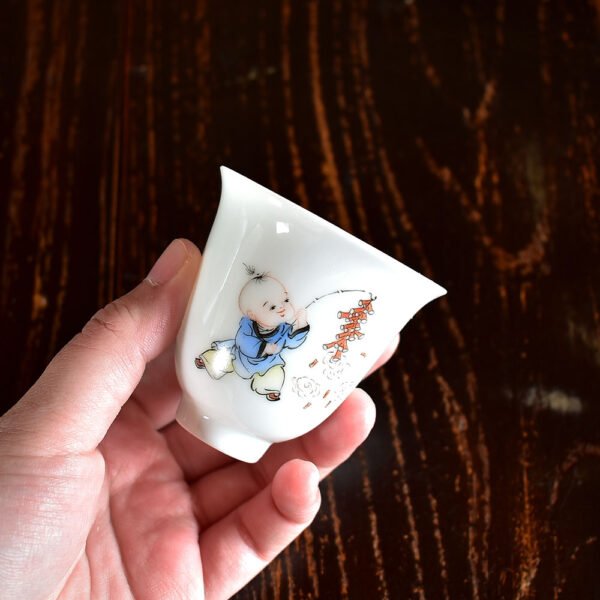 $45.99
$45.99The teacup is made from high-quality white mud, giving it a smooth and elegant texture. The surface is covered in a lovely white glaze, which creates a beautiful and glossy finish. The cup is adorned with overglaze colours in two different patterns.
One of the patterns depicts children setting off firecrackers, a symbol of celebration and joy in Chinese culture. The other pattern shows a child with good fortune, representing prosperity and good luck. Both patterns are intricate and detailed, featuring vibrant colours that contrast beautifully against the white background.
Due to being entirely hand-painted, each painting has slight differences.
-
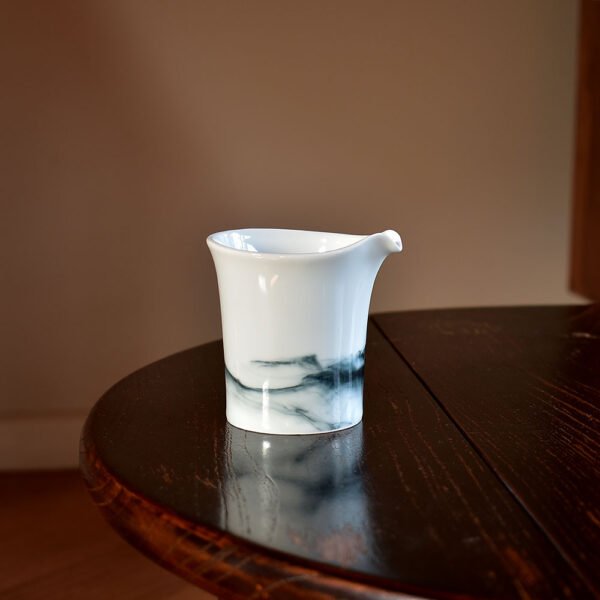
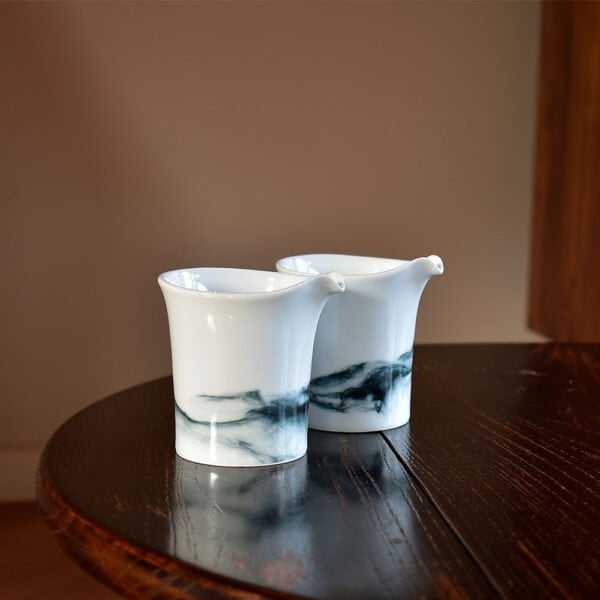 $49.99
$49.99This handmade fair cup is adorned with a unique impressionistic Chinese ink landscape painting. Made from white jade ceramic, it has a smooth texture and a minimalist style that complements its elegant design. The fair cup maintains a sense of simplicity, making it perfect for enjoying a cup of tea in a calm and peaceful setting. Its smooth texture and minimalist style make it a pleasure to hold and admire, adding to its overall sense of tranquillity and refinement.
-
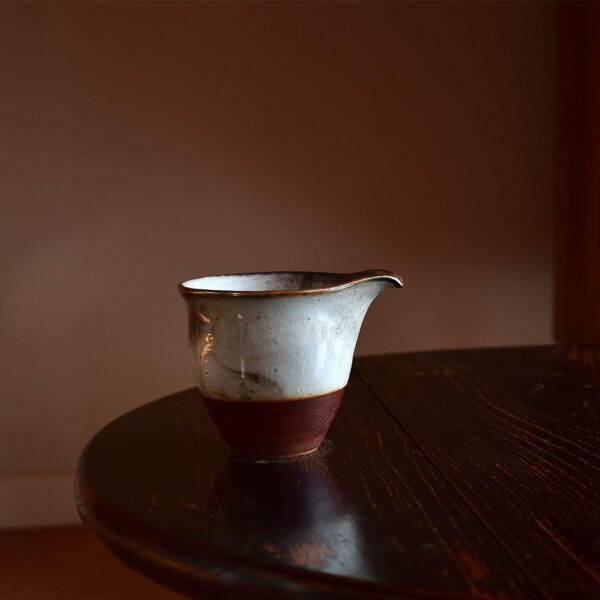
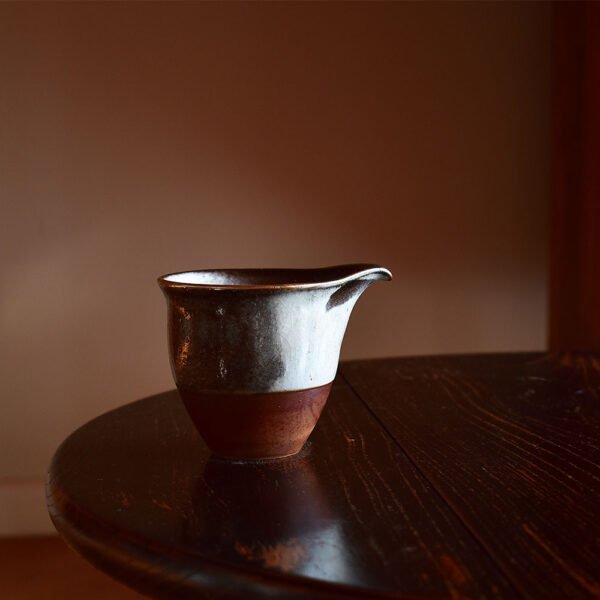 Out of Stock
$44.99
Out of Stock
$44.99This fair cup was baked with firewood and was made of both kiln-fired glaze variations and coloured & cracked glaze craft. Each one is unique and handmade – no two being exactly alike.
The overall design of this fair cup is simple and unsophisticated. The unique cracked glaze technique used creates beautiful patterns on the cup’s surface. Over time as it is soaked with tea soup, then resulting variations in the pattern make each piece truly outstanding and add more enjoyment to the tea-drinking experience.
Attention:
- Kiln-fired glaze variations are often unpredictable and can result in a wide range of colours from a single firing.
- The porosity of ceramics varies depending on the materials used, the recipe, the pressure applied, the duration of pressure, the thickness of the body, the firing temperature, and the duration of firing. Generally, the finer the porcelain, the smaller the pores, while the coarser the pottery, the larger the pores.
- Since porcelain is made from clay, the amount of iron spots present in the clay varies depending on the mineral content of the soil. These iron spots are harmless and do not affect the use of the porcelain. Removing them would require the use of chemical materials, which can be damaging to high-quality porcelain.
- Handmade products are not perfect, and each piece can have differences in size, shape, colour, and other aspects.
-
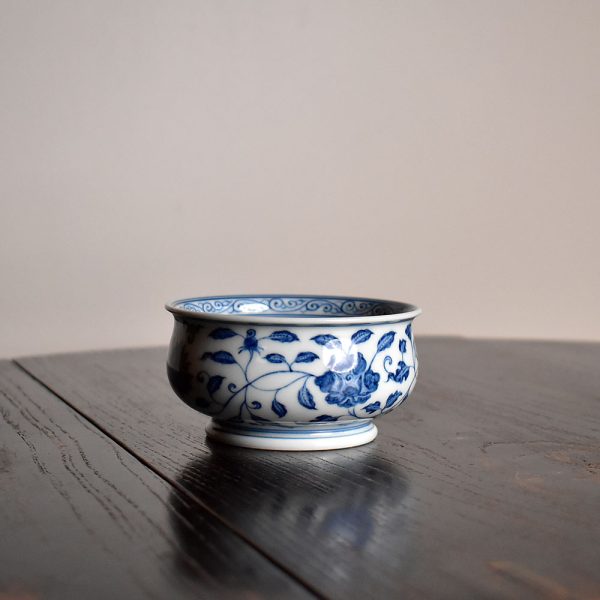
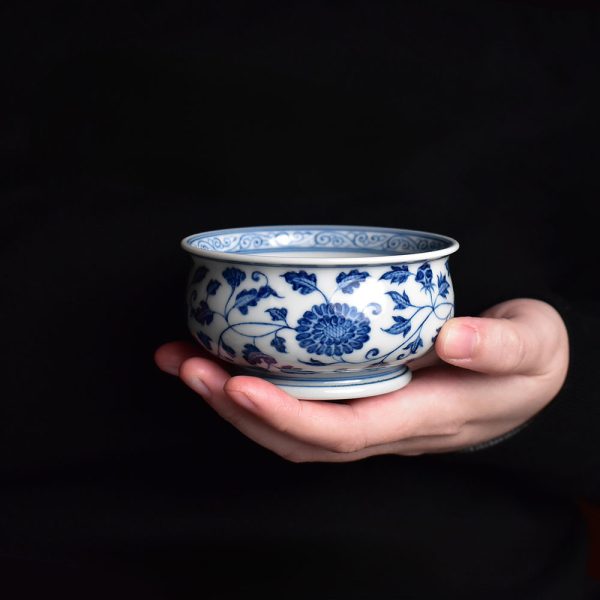 New
$529.99
New
$529.99This teacup takes the classic form of a master’s master teacup with a censer-like profile. The rim flares slightly outward, the belly is full, and the foot ring is steady and well balanced. The overall lines are simple and dignified, lending an elegant presence on the tea table.
The outer wall is painted in blue and white with entwined lotus motifs, with branches and blossoms interwoven, symbolizing continuity and vitality. At the bottom of the interior lies a single lotus, its full bloom and spreading petals representing purity, integrity, and auspiciousness. This design approach of outer complexity and inner simplicity not only enhances its decorative beauty but also carries cultural meanings rooted in Confucian and Buddhist traditions.
The blue coloration is pure and refined, the contrast of blue and white crisp and harmonious, with a glossy and smooth glaze. Whether admired on a desk or used during tea gatherings, it reflects the taste and elegance of its owner.
As a master master teacup, it serves not only as the exclusive tea vessel signifying the host’s role in a tea setting but also as a symbol of etiquette and respect during refined gatherings.
-
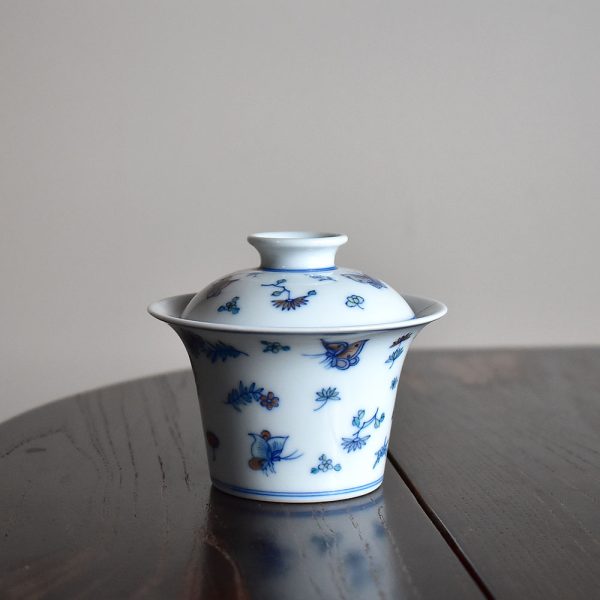
 $739.99
$739.99This exquisite Gaiwan from Jingdezhen showcases the traditional Doucai technique, featuring a unique horseshoe-shaped body. The flared rim and flowing lines create an elegant silhouette that fits naturally in the hand—comfortable to hold, heat-insulated, and aesthetically refined.
The piece is themed around the classic motif ‘Butterfly Loves the Flower’ with hand-painted butterflies fluttering gracefully among swaying floral branches. The composition is airy and poetic, expressing an ethereal charm. In Chinese culture, this motif has long symbolised romantic love, freedom of the soul, and vitality. In classical poetry and art, butterflies often represent delicate emotions and mutual affection, while flowers signify beauty and ideal moments—together, they portray love’s longing and fulfilment.
Crafted using the Doucai method—an imperial decorative style originating in the Ming Dynasty’s Chenghua period—the process is intricate. First, outlines are painted in underglaze cobalt blue and fired at high temperature. Then, overglaze enamels are applied to add colour before a second low-temperature firing. The result is a harmonious interplay of subdued blue and vibrant enamel tones, with rich layers and refined softness. Doucai is celebrated as a pinnacle of Chinese ceramic artistry, known for its elegance and depth.
The Gaiwan’s lid, bowl, and saucer are proportioned with precision. The gently rounded rim is smooth to the touch and slightly flared to prevent burns, offering a pleasant handling experience. This Doucai Gaiwan is not only a functional teaware piece but also a collectible artwork steeped in cultural and aesthetic significance—ideal for daily tea sessions, refined tea tables, or as a meaningful gift.
Whether enjoyed in solitary serenity or shared with friends, it brings a touch of poetic grace to each moment of tea.
-
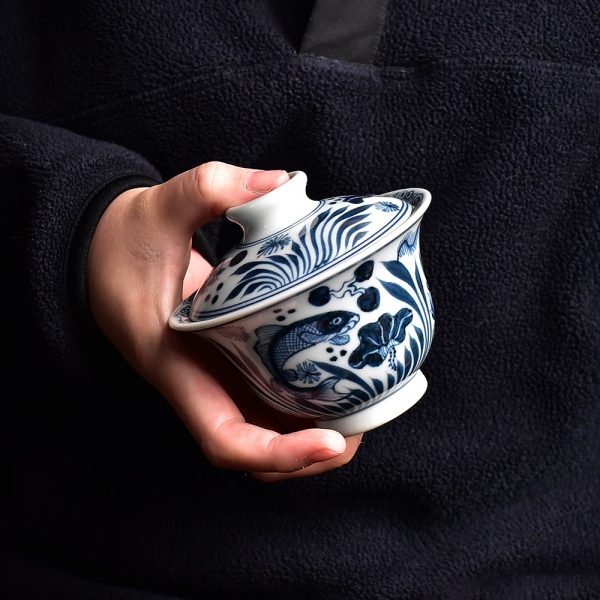
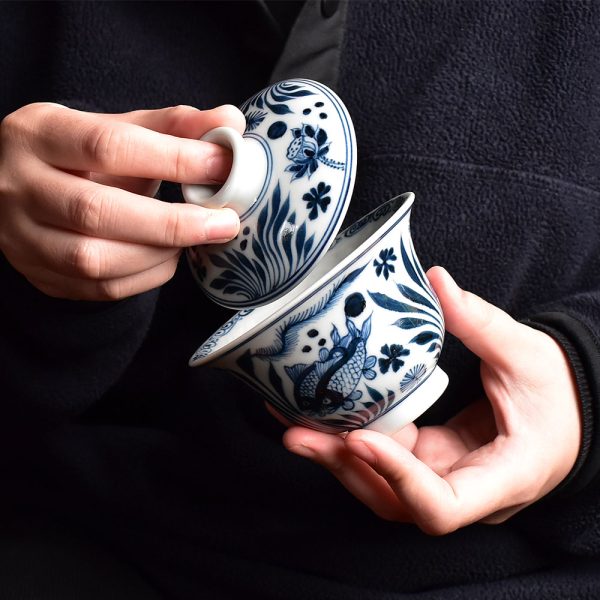 $598.99
$598.99This Yuan-style blue and white fish-and-waterweed gaiwan is crafted using traditional Jingdezhen underglaze blue techniques. The body is sturdy, with a well-balanced form that exudes classical elegance. On the outer surface, vivid hand-painted carp swim gracefully among waving aquatic plants. The composition is lively and natural—the fish scales are delicately rendered, and the water plants sway in dynamic rhythm, revealing the artist’s refined brushwork and artistic finesse.
What sets this piece apart lies within: the interior of the gaiwan features an intricately incised design of fish and weeds, subtly hidden beneath the glaze. As light moves across the surface, the design gradually emerges like a submerged relief, as if the fish are gliding beneath the tea, adding a poetic and graceful charm to the tea experience.
The special pattern of this teacup is fish and seaweed. Since ancient times, fish and seaweed motifs have been traditional decorative patterns in ceramics, representing auspiciousness and carrying rich cultural and aesthetic meanings. The homophonic association between fish and the Chinese word for “surplus” (yu) makes fish a symbol of abundance and wealth. Fish motifs are often used to convey the meaning of “abundance and surplus,” “prosperity year after year” (as the pronunciation of fish is similar to that of “surplus” in Chinese), and “auspicious celebrations and abundance.” The fish and seaweed motifs typically feature fish as the central element, with additional decorations such as water plants, forming a variety of decorative patterns. The depiction of four swimming fish in the artwork symbolizes the concept of “surplus in all four seasons,” representing a year-round surplus, which carries a highly positive connotation. Such motifs are not only favoured by the royal court but also beloved by people from all walks of life as auspicious decorations. The flexible composition, auspicious symbolism, and abundant variations of fish and seaweed motifs have made them timeless classics throughout different eras.
For Yuan blue and white porcelain refers to the blue and white porcelain produced during the Yuan dynasty (1271-1368) in China. The Yuan dynasty was an important period in the history of Chinese porcelain and one of the peaks of Chinese porcelain art. As one of the representatives of that era, Yuan blue and white porcelain exhibited unique artistic styles and technical levels. The characteristic of Yuan blue and white is the use of cobalt blue pigment for painting, which is made of cobalt oxide. After firing, the colour is bright and rich, with extremely high decorative effect. Yuan blue and white porcelain has various shapes, thick and heavy, concise, and fluent lines, and stable and solemn shapes, all made exquisitely.
The evolution of Yuan blue and white is based on the foundation of Tang and Song celadon. Firstly, the glaze colour was improved and innovated. Unique white glaze, eggshell glaze and blue-white glaze were invented to make the glaze crystal clear. Cobalt pigment was imported for glaze colouring. Or using the pigment made from domestic materials.
The formation of tin spots on Yuan blue and white is due to the high content of iron elements in local parts of the blue pigment. After reaching saturation in the high-temperature glaze solution and cooling down, the iron elements in the supersaturated part start to precipitate. If the iron content of the blue pigment is higher and the cooling rate is appropriate, tin spots are more likely to appear on the surface of the ware.
In addition to firing and materials, the formation of tin spots also involves the factor of glaze material. During the painting process, tin spots can also be formed due to the accumulation of blue pigment. Tin spots are more likely to appear on the surface of the ware at the intersections and the starting and ending points of brushstrokes. The formation of tin spots can be said to be a natural creation or an artificial decoration.
This gaiwan has a thick body and uses the Su Ma Li Qing glaze material (a kind of blue pigment), with a heavy sense of tin spots, revealing a unique charm of the past era. The entire production process is completed by hand, and every detail has been carefully designed and polished, giving this teacup a unique artistic charm. The blue and white fish & seaweed pattern is vivid, showcasing ancient cultural and aesthetic values, allowing people to immerse themselves in a beautiful artistic atmosphere while enjoying their tea.
-

 $649.99
$649.99This teacup is made in the style of the Yuan dynasty blue and white porcelain, completely handmade and hand painted. The pattern of “一鹭莲科” or “一路连科” in Chinese culture is derived from the beautiful combination of the heron and lotus leaves. As “鹭” (heron) and “路” (path/road) have the same pronunciation, and “莲” (lotus) sounds like “连” (successive/continuous), the name “一路连科” is a play on words that conveys the beautiful meaning of the pattern. In ancient times, successive successful candidates in the imperial examinations were called “连科,” and “一路连科” is a good wish for students to have a smooth career path and achieve success step by step.
For Yuan blue and white porcelain refers to the blue and white porcelain produced during the Yuan dynasty (1271-1368) in China. The Yuan dynasty was an important period in the history of Chinese porcelain and one of the peaks of Chinese porcelain art. As one of the representatives of that era, Yuan blue and white porcelain exhibited unique artistic styles and technical levels. The characteristic of Yuan blue and white is the use of cobalt blue pigment for painting, which is made of cobalt oxide. After firing, the colour is bright and rich, with extremely high decorative effect. Yuan blue and white porcelain has various shapes, thick and heavy, concise, and fluent lines, and stable and solemn shapes, all made exquisitely.
The evolution of Yuan blue and white is based on the foundation of Tang and Song celadon. Firstly, the glaze colour was improved and innovated. Unique white glaze, eggshell glaze and blue-white glaze were invented to make the glaze crystal clear. Cobalt pigment was imported for glaze colouring. Or using the pigment made from domestic materials.
The formation of tin spots on Yuan blue and white is due to the high content of iron elements in local parts of the blue pigment. After reaching saturation in the high-temperature glaze solution and cooling down, the iron elements in the supersaturated part start to precipitate. If the iron content of the blue pigment is higher and the cooling rate is appropriate, tin spots are more likely to appear on the surface of the ware.
In addition to firing and materials, the formation of tin spots also involves the factor of glaze material. During the painting process, tin spots can also be formed due to the accumulation of blue pigment. Tin spots are more likely to appear on the surface of the ware at the intersections and the starting and ending points of brushstrokes. The formation of tin spots can be said to be a natural creation or an artificial decoration.
While this Lian Sheng Yuan Xi teacup retains the bold and rich coloration of classic Yuan blue and white porcelain, its tin-spot effect is relatively subtle, giving it a more delicate and refined appearance. The overall aesthetic is graceful and elegant, embodying a scholarly charm. Compared to the traditionally bold and unrestrained Yuan blue and white style, this piece leans towards a more understated and sophisticated aesthetic, blending classic heritage with a softer, more literary elegance. It brings a sense of warmth and refinement to any tea session, offering a harmonious balance between history and artistry.
-

 $35.99
$35.99This fair cup is crafted using the traditional white slip technique, offering a raw yet refined texture that highlights the unique beauty of handmade pottery. The exterior features a richly textured surface, reminiscent of the natural skin of the earth, while the interior is coated with a smooth, delicate white glaze. This contrast between the rough and the refined creates a harmonious balance of rustic charm and elegance.
Design Highlights:
- White Slip Technique: The exterior is finished with the white slip glazing method, allowing the clay body to reveal a soft, misty white gradient. This process gives the piece a warm, timeworn patina, making each one uniquely distinct.
- Organic Texture: The hand-shaped body showcases flowing woodgrain-like patterns, offering a tactile, natural feel that exudes simplicity and authenticity.
- Smooth Pouring Spout: Designed with a gracefully curved spout, ensuring a seamless, drip-free pour for a more refined tea-serving experience.
- Wide-Mouth Design: The broad opening allows for easy observation of the tea liquor’s color while ensuring an even, controlled flow, reducing tea sediment accumulation.
- Stable Base: Well-proportioned footed base provides stability, making it an ideal companion for various tea settings.
This fair cup seamlessly blends traditional craftsmanship with contemporary aesthetics, making it a practical and elegant addition to any tea ceremony. Its rustic texture and warm glazing lend a sense of ritual to every pour, enhancing the overall tea experience.
-

 Out of Stock
$499.99
Out of Stock
$499.99This Gaiwan is meticulously handcrafted using the Red Underglaze technique, a process known for its exceptional difficulty and low yield. Red Underglaze uses copper as a colorant, painted directly onto the white porcelain body in intricate patterns before being coated with a layer of glaze. During high-temperature reduction firing, the copper produces a striking red hue, giving this technique its name. The vibrant, rich red contrasts beautifully with the pure white porcelain, highlighting the unique texture and elegance of Red Underglaze craftsmanship.
The Gaiwan’s design features trailing lotus motifs, a classic Chinese decorative theme. Traditionally, the trailing lotus, known as the “Vine of Longevity” for its interwoven and continuous blooms, symbolizes prosperity and endless vitality. In Confucian culture, the lotus is a representation of truth, goodness, and beauty, as well as a sacred emblem in Buddhism. The phonetic similarity between “lotus” and “continuity” in Chinese further conveys a wish for enduring blessings and harmonious emotions. As an enduring element of traditional Chinese design, the trailing lotus combines cultural depth with artistic beauty, embodying purity, elegance, and timeless sophistication.
The Gaiwan is perfectly proportioned, featuring a rounded and full lid knob and a lip designed for a comfortable grip. The saucer base is adorned with traditional geometric patterns, adding a touch of classical charm.
This Red Underglaze Gaiwan is a rare blend of artistry and practicality. The precious Red Underglaze technique bridges ancient craftsmanship with modern aesthetics, creating a masterpiece where the deep, fiery red seems to dance like flames upon the pristine white porcelain. It radiates an aura of elegance and refinement, making it a truly exceptional piece.
-

 $299.99
$299.99This Stem Teacup is meticulously handcrafted using the blue-and-white with underglaze red technique. In tea culture, the stem cup symbolizes solemnity and elegance. When using a stem cup for tea tasting, the graceful motion of raising the cup evokes a sense of timeless charm, as if immersed in the serene ambiance of ancient traditions, adding a touch of ritual and intrigue to the tea experience. Besides that, the artwork features camellia flowers, symbolising passion and beauty, often used to convey auspiciousness and blessings for happiness.
Blue-and-White with Underglaze Red (commonly known as “blue-and-purple”) is a ceramic decorative method in which underglaze red designs are added to blue-and-white patterns. Blue-and-white refers to patterns drawn with cobalt oxide, covered with a transparent glaze, and fired at over 1200°C in a reduction atmosphere to produce the characteristic underglaze decoration. Underglaze red uses copper oxide as a colouring agent, painted directly on the clay body (or on clay coated with a transparent white glaze), then covered with a clear glaze. After being placed in a saggar and fired at 1250–1280°C in a strong reduction atmosphere, the high-valence copper is reduced to low-valence copper, creating vivid yet subdued red patterns.
In this technique, underglaze red can be used to decorate the spaces between blue-and-white patterns, resulting in the unique combination known as blue-and-white with underglaze red. This complex process creates a striking artistic effect where blue, red, and white colours complement each other.
The production of blue-and-white with underglaze red ceramics is extraordinarily challenging. Historically, some artisans risked financial ruin in their pursuit of this technique due to its complexity. The difficulty arises because the cobalt (blue) and copper (red) oxides require different reduction temperatures, making it exceptionally hard to control the process. This results in a low success rate, with issues such as “flying red,” where the red and blue merge or the colours become indistinct and blurry.
Despite these challenges, the combination of blue-and-white with underglaze red achieves an unparalleled artistic effect, where the interplay of blue, red, and white elevates the beauty of ceramics to new artistic heights. This stem teacup exemplifies the mastery of this rare and sophisticated craft, making it a stunning and meaningful piece of art.
-

 Out of Stock
$299.99
Out of Stock
$299.99This censer-style cup is handcrafted using the underglaze red technique. The shape is inspired by ancient censer designs, embodying a rich cultural heritage while showcasing a distinctive artistic beauty. The cup’s form features a simple and dignified tone, with smooth and natural lines. The rim gently flares outward, exuding elegance, while the body is rounded and well-balanced, providing a sense of visual harmony and comfort.
The beauty of the censer-style cup lies not only in its exterior design but also in the meticulous attention to detail and craftsmanship. The proportion of the rim is perfectly calibrated for a comfortable grip when drinking. The base slightly tapers inward, adorned with classic meander patterns, adding visual depth and incorporating the traditional Chinese cultural symbolism of “endlessness and continuity.”
Moreover, underglaze red is an exceptionally challenging technique, with a very low success rate. It uses copper as the coloring agent, with patterns directly painted onto the white porcelain body and then covered with a transparent glaze. During firing in a high temperature reducing flame, the copper elements produce a vivid red hue, giving the name “underglaze red.” The rich and vibrant red contrasts sharply with the pure white porcelain, highlighting the unique texture and beauty of the underglaze red.
The entire cup features intertwining lotus patterns as its main motif. In traditional symbolism, the intertwining lotus, known as “wan shou teng” (longevity vine), represents blessings and continuity due to its layered structure and endless growth. In Confucian culture, the lotus symbolizes purity, truth, and beauty, while also being associated with Buddhism. The Chinese word for lotus, “莲” (lián), is a homophone for “连” (continuity), expressing heartfelt wishes and good fortune. As part of traditional Chinese decorative motifs, the intertwining lotus has been passed down through generations, appreciated for both its aesthetic charm and cultural significance. The lotus embodies a sacred and pure elegance—beautiful without being flamboyant, refined without being ostentatious—making it a popular decorative element in everyday life.
This underglaze red censer-style cup is a treasure that perfectly integrates art and practicality. By utilizing the precious underglaze red technique, it harmoniously combines ancient craftsmanship with modern aesthetics. The deep red, reminiscent of dancing flames, shines brilliantly against the pure white porcelain, exuding an aura of nobility and sophistication.
-

 $138.99
$138.99This lovely teapot, adorned with the pattern “The Jade Rabbit Looks at the Moon,” is a beautiful piece that combines traditional Chinese artistry with exquisite craftsmanship.
Design and Appearance:
- Pattern: The teapot features an elegant design with the motif “The Jade Rabbit Looks at the Moon.” This pattern depicts two white rabbits gazing up at a full moon, surrounded by delicate bamboo leaves, creating a serene and poetic scene.
- Color: The teapot is covered with a bright yellow glaze, featuring rich and vibrant colors. The use of famille rose technique brings the entire overglaze painting to life, making it vivid and full of charm.
Craftsmanship and Techniques:
- Yellow Glaze: The use of yellow glaze is a special technique in Chinese porcelain art. It involves applying a yellow pigment over the ceramic body before firing it in the kiln. This process gives the teapot its striking and vibrant yellow color.
- Famille Rose: Famille rose, or “fencai” in Chinese, is a type of enamel decoration on porcelain. This technique uses a palette of soft and delicate colors, which are painted over the glaze and then fired at a lower temperature. The famille rose technique is evident in the detailed depiction of the rabbits, the moon, and the bamboo leaves, which are finely painted with soft and harmonious colors.
Symbolism and Cultural Significance:
The meaning of “The Jade Rabbit Looks at the Moon” primarily expresses deep longing for loved ones. This meaning originates from an ancient mythological story where the jade rabbit requests to reside in the Moon Palace to accompany Chang’e, thus creating the image of the jade rabbit looking at the moon. This story not only showcases the jade rabbit’s kindness and care for family but also reflects the ancients’ emphasis on family and kinship. In traditional Chinese culture, “The Jade Rabbit Looks at the Moon” is not only a symbol of the Mid-Autumn Festival but also an important cultural element for expressing longing and the desire for reunion.
This teapot is a fine example of traditional Chinese porcelain artistry, combining the vibrant yellow glaze with the delicate and intricate famille rose painting. The “Jade Rabbit Looks at the Moon” motif adds a touch of cultural richness and poetic beauty, making it not only a functional piece for brewing tea but also a beautiful decorative item that can be cherished and admired.
-

 Out of Stock
$65.99
Out of Stock
$65.99This Kiln-Transformed Aurora Blue Glaze Gourd-Shaped Fairness Cup is a fine piece that combines traditional craftsmanship with modern aesthetics. Its unique design and variable glaze color present a stunning aurora-like effect.
Design and Appearance
- Shape: The fairness cup features a gourd-shaped design with smooth, flowing lines, making it both aesthetically pleasing and practical. The design of the spout allows for controlled pouring, preventing spills.
- Glaze Color: The exterior glaze is primarily aurora blue, showcasing a rich variety of colors. It transitions from deep blue to soft white, resembling the dance of the aurora in the night sky. The interior glaze is mainly purple and blue, presenting a mysterious starry sky effect.
Craftsmanship and Techniques
- Kiln-Transformation Technique: Kiln-transformation involves controlling the temperature and atmosphere during firing to create natural and unpredictable changes in the glaze. Each kiln-transformed porcelain piece is unique, with different glaze colors and patterns. This fairness cup’s glaze naturally flows during firing, creating beautiful color gradients and texture effects.
- Aurora Blue Glaze: Aurora blue glaze is a special type of glaze that, after high-temperature firing, presents variations in blue and other colors. This glaze is not only visually stunning but also highly durable and resistant to corrosion.
Function and Practicality
- Purpose of the Fairness Cup: In tea ceremonies, a fairness cup is used to evenly distribute tea, ensuring each participant receives tea of the same concentration. The gourd-shaped design is not only beautiful but also offers a comfortable grip and practical use.
- Artistic Value: This fairness cup is not just a practical tea utensil but also a piece of art. Its unique glaze color variation and elegant shape make it highly collectible and visually appealing.
This Kiln-Transformed Aurora Blue Glaze Gourd-Shaped Fairness Cup is a charming tea utensil, whether for daily use or as a collectible art piece. Every use is an appreciation and enjoyment of traditional craftsmanship and modern aesthetics.
Attention:
- Kiln-fired glaze variations are often unpredictable and can result in a wide range of colours from a single firing.
- The porosity of ceramics varies depending on the materials used, the recipe, the pressure applied, the duration of pressure, the thickness of the body, the firing temperature, and the duration of firing. Generally, the finer the porcelain, the smaller the pores, while the coarser the pottery, the larger the pores.
- Since porcelain is made from clay, the amount of iron spots present in the clay varies depending on the mineral content of the soil. These iron spots are harmless and do not affect the use of the porcelain. Removing them would require the use of chemical materials, which can be damaging to high-quality porcelain.
- Handmade products are not perfect, and each piece can have differences in size, shape, colour, and other aspects.
-

 $59.99
$59.99This Kiln-Transformed Aurora Blue Glaze Gourd-Shaped Fairness Cup is a fine piece that combines traditional craftsmanship with modern aesthetics. Its unique design and variable glaze color present a stunning aurora-like effect.
Design and Appearance
- Shape: The fairness cup features a gourd-shaped design with smooth, flowing lines, making it both aesthetically pleasing and practical. The design of the spout allows for controlled pouring, preventing spills.
- Glaze Color: The exterior glaze is primarily aurora blue, showcasing a rich variety of colors. It transitions from deep blue to soft white, resembling the dance of the aurora in the night sky. The interior glaze is mainly purple and blue, presenting a mysterious starry sky effect.
Craftsmanship and Techniques
- Kiln-Transformation Technique: Kiln-transformation involves controlling the temperature and atmosphere during firing to create natural and unpredictable changes in the glaze. Each kiln-transformed porcelain piece is unique, with different glaze colors and patterns. This fairness cup’s glaze naturally flows during firing, creating beautiful color gradients and texture effects.
- Aurora Blue Glaze: Aurora blue glaze is a special type of glaze that, after high-temperature firing, presents variations in blue and other colors. This glaze is not only visually stunning but also highly durable and resistant to corrosion.
Function and Practicality
- Purpose of the Fairness Cup: In tea ceremonies, a fairness cup is used to evenly distribute tea, ensuring each participant receives tea of the same concentration. The gourd-shaped design is not only beautiful but also offers a comfortable grip and practical use.
- Artistic Value: This fairness cup is not just a practical tea utensil but also a piece of art. Its unique glaze color variation and elegant shape make it highly collectible and visually appealing.
This Kiln-Transformed Aurora Blue Glaze Gourd-Shaped Fairness Cup is a charming tea utensil, whether for daily use or as a collectible art piece. Every use is an appreciation and enjoyment of traditional craftsmanship and modern aesthetics.
Attention:
- Kiln-fired glaze variations are often unpredictable and can result in a wide range of colours from a single firing.
- The porosity of ceramics varies depending on the materials used, the recipe, the pressure applied, the duration of pressure, the thickness of the body, the firing temperature, and the duration of firing. Generally, the finer the porcelain, the smaller the pores, while the coarser the pottery, the larger the pores.
- Since porcelain is made from clay, the amount of iron spots present in the clay varies depending on the mineral content of the soil. These iron spots are harmless and do not affect the use of the porcelain. Removing them would require the use of chemical materials, which can be damaging to high-quality porcelain.
- Handmade products are not perfect, and each piece can have differences in size, shape, colour, and other aspects.
-
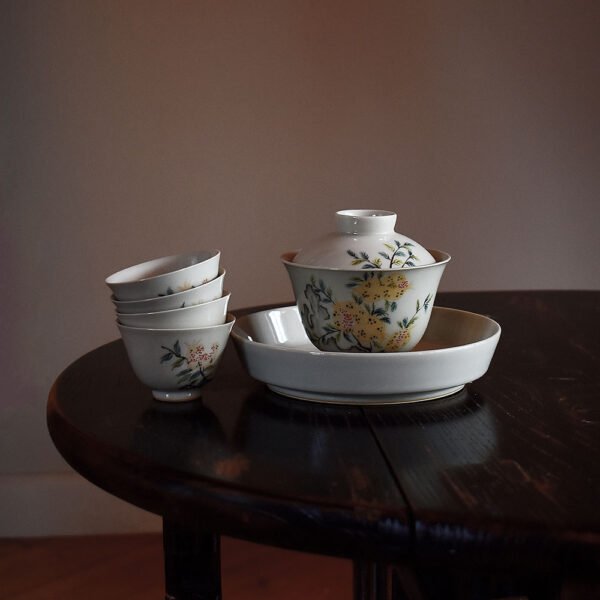
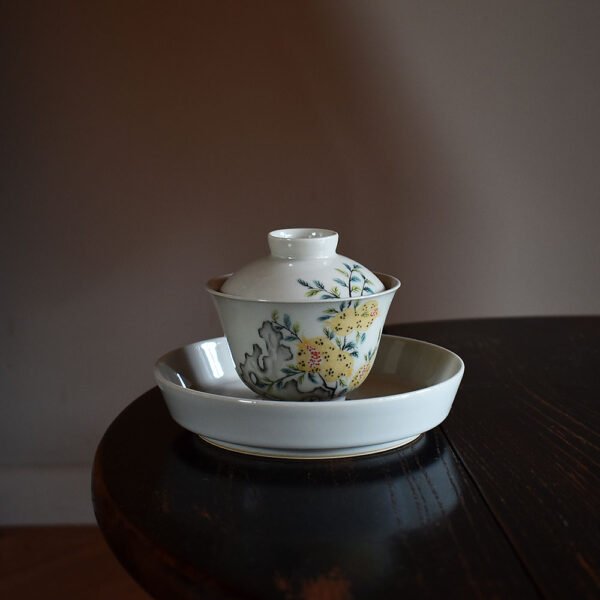 $345.99
$345.99This tea set is made with antique clay glaze, which gives it a smooth and lustrous surface, as well as a thick and sturdy body, evoking a sense of ancient elegance, tranquillity, and warmth. The hand-painted strokes are lively and natural, depicting the pomegranate with lifelike accuracy.
Furthermore, the Gaiwan is crafted using the overglaze colour painting craft, which produces pure, vibrant, and full colours. Since Gaiwan is hand-painted by an artist, every piece is unique and machine-printed decals cannot be compared with.
-
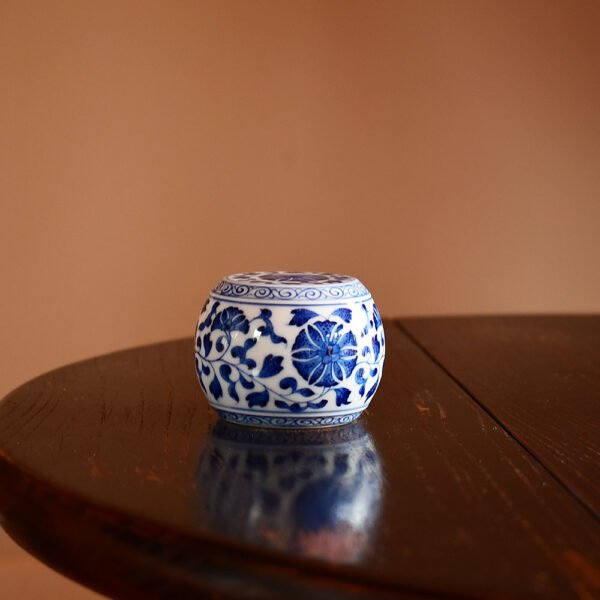
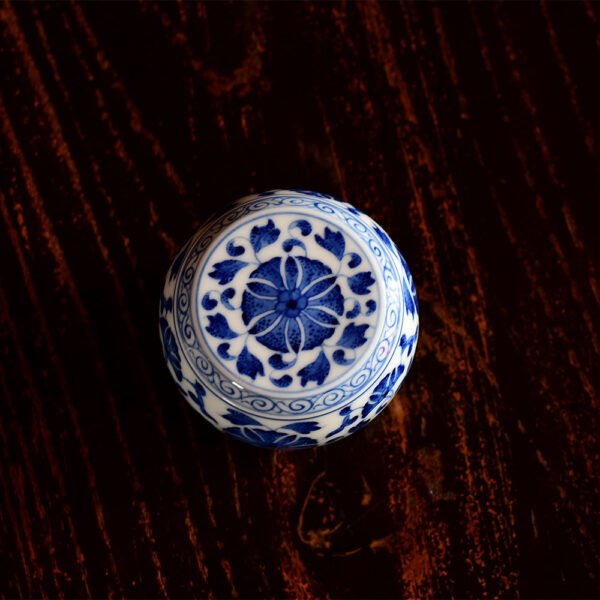 Out of Stock
$75.99
Out of Stock
$75.99This cover is fully hand-painted using the blue and white underglaze technology. It is an essential item for many people when brewing tea. It is used to hold teapot lids, Gaiwan lids, and cup lids. It not only keeps the lids of the teaware clean but also prevents them from wetting the tabletop.
Chanzhi Lian, also known as “Interlock Branch Lotus,” is a Chinese decorative motif with the symbolism of “flowers within flowers, blossoms within leaves.” It is also referred to as the “Wanshou Teng,” representing auspiciousness and longevity due to its continuous and interconnected structure, symbolizing the concept of “endless vitality.” In addition, in traditional Chinese Confucian culture, the lotus is seen as the embodiment of truth, goodness, and beauty, as well as a symbol of Buddhism. The pronunciation of “Lian” is similar to the word “continuous” in Chinese, further expressing the idea of continuous growth and conveying positive wishes and emotions.
As part of Chinese traditional ornamentation, Chanzhi Lian has been passed down through generations, reflecting its own beauty and cultural significance with a unique artistic charm. The lotus possesses a sacred and pure temperament, being beautiful without being ostentatious and magnificent without being vulgar. It is precisely because of this aesthetic appeal that Chanzhi Lian has become a decorative pattern applied to various aspects of life.
In this lid saucer, the delicate brushstrokes vividly outline the pattern, creating a glossy and elegant appearance. The colours are rich and vibrant, giving the piece a sense of vivid and liveliness.
Note: All are fully handmade, every lid saucer can be slightly different.
-

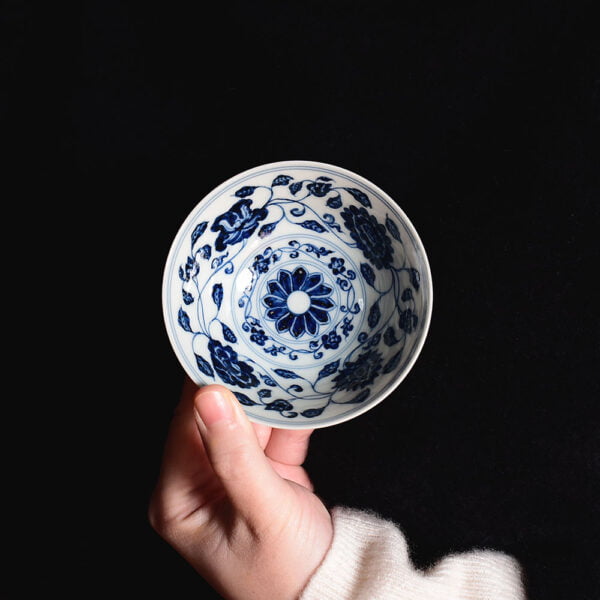 $559.99
$559.99The style of this super beautiful teacup is Ming, using the underglaze blue technique, and entirely handcrafted and hand painted. The pattern features the classic design of intertwining lotus branches (Chanzhi Lian). What’s even more astonishing is the delicate craftsmanship of this teacup creates a thinness akin to cicada wings, a brilliance reminiscent of glass, and a weightless feel as floating clouds. When held up to the light, the intricately drawn interlocking lotus pattern inside the cup faintly emerges, elusive yet enchanting. It’s as if colorful clouds chase the moon, casting a misty glow, a sight so beautiful it’s beyond words, captivating, and mesmerizing.
The pattern of this beautiful teacup is Chanzhi Lian, which is also known as ‘intertwining lotus branches’ or ‘Interlock Branch Lotus’, which is a Chinese decorative motif with the symbolism of “flowers within flowers, blossoms within leaves.” It is also referred to as the “Wanshou Teng,” representing auspiciousness and longevity due to its continuous and interconnected structure, symbolizing the concept of “endless vitality.” In addition, in traditional Chinese Confucian culture, the lotus is seen as the embodiment of truth, goodness, and beauty, as well as a symbol of Buddhism. The pronunciation of “Lian” is similar to the word “continuous” in Chinese, further expressing the idea of continuous growth and conveying positive wishes and emotions.
As part of Chinese traditional ornamentation, Chanzhi Lian has been passed down through generations, reflecting its own beauty and cultural significance with a unique artistic charm. The lotus possesses a sacred and pure temperament, being beautiful without being ostentatious and magnificent without being vulgar. It is precisely because of this aesthetic appeal that Chanzhi Lian has become a decorative pattern applied to various aspects of life.
The Ruyi motifs on the outside of this teacup also carry auspicious meanings. The Ruyi symbolizes auspiciousness and good fortune. Its rounded and flawless form embodies blessings, satisfaction, and wishes fulfilled. Underneath its graceful appearance, it holds profound significance, representing the auspicious and delightful ideals of good fortune and contentment.
In addition, the beautiful tin spots on the porcelain add even more unique charm to it. The formation of tin spots is due to the high content of iron elements in local parts of the blue pigment. After reaching saturation in the high-temperature glaze solution and cooling down, the iron elements in the supersaturated part start to precipitate. If the iron content of the blue pigment is higher and the cooling rate is appropriate, tin spots are more likely to appear on the surface of the ware.
In addition to firing and materials, the formation of tin spots also involves the factor of glaze material. During the painting process, tin spots can also be formed due to the accumulation of blue pigment. Tin spots are more likely to appear on the surface of the ware at the intersections and the starting and ending points of brushstrokes. The formation of tin spots can be said to be a natural creation or an artificial decoration. These tin glazes not only add a rustic texture to the teacup but also imbue it with a unique sense of history.
The delicate brushstrokes and intricate detailing of the painting on this teacup create a distinct sense of aesthetic appeal. The stunning underglaze blue, along with the heavy tin glaze, gives it a bold and intense beauty. The thin-walled body also adds another layer of beauty to it. This teacup exudes a simple yet luxuriant charm, reminiscent of the style of imitation Ming, making it truly captivating and irresistible.
-
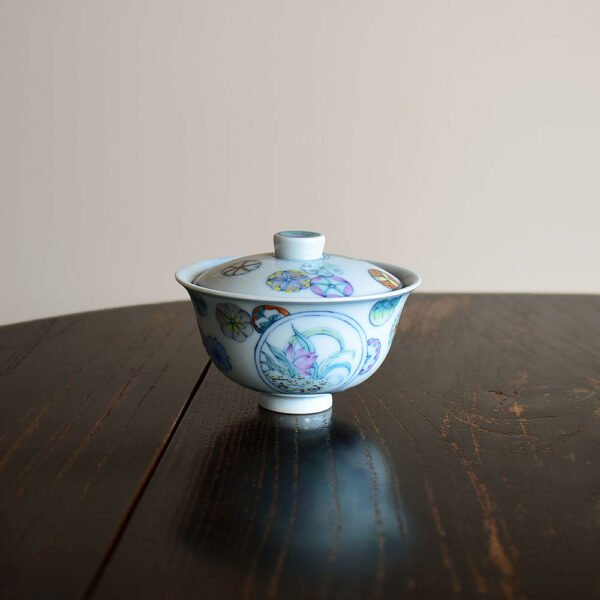
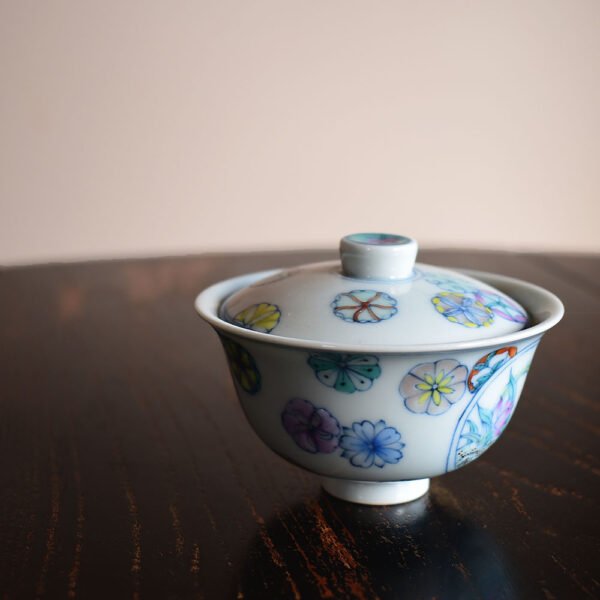 $339.99
$339.99This small and delicate Dou Cai Pi Qiu Hua Gaiwan is meticulously crafted with the technique of clashing colour.
As we all know, Doucai is a precious art form in traditional Chinese porcelain craftsmanship. It originated and was fired during the Xuande period of the Ming Dynasty, and Dou Cai from the Chenghua period of the Ming Dynasty is highly esteemed. Dou Cai is a type of decoration that combines underglaze blue (qinghua) and overglaze colour painting.
Dou Cai involves applying mineral pigments onto the previously fired underglaze blue porcelain, filling in the gaps left by the underglaze blue patterns and colouring the space within the outline of the underglaze blue design. The porcelain is then fired in a lower-temperature kiln (800°C). Dou Cai is renowned for its vibrant and varied colour palette, as well as its refined and sophisticated decorative style that reflects the aesthetic taste of the Ming Dynasty.
The decorative pattern of Pi Qiu Hua (皮球花), also known as little tuan hua (小团花) or embroidery ball flower, evolved from the traditional tuan hua pattern on porcelain. This pattern has been present since the Sui Dynasty, and it combines abstract and representational elements. It takes various forms, resembling a spherical shape, hence the name Pi Qiu Hua (皮球花).
The decorative patterns on Chinese porcelain always carry auspicious meanings. Since the Pi Qiu Hua pattern originated from tuan hua, it inherits the traditional tuan hua motifs such as tuan long (团龙), tuan feng (团凤), and tuan hua (团花). These traditional motifs symbolize the abundance and beauty of life.
This beautiful Gaiwan, with its vibrant colours and exquisite craftsmanship, is an eye-catching presence wherever it is placed. Imagine having a cup of spring tea by using this charming Gaiwan, it could be the most delightful experience for a day!
-
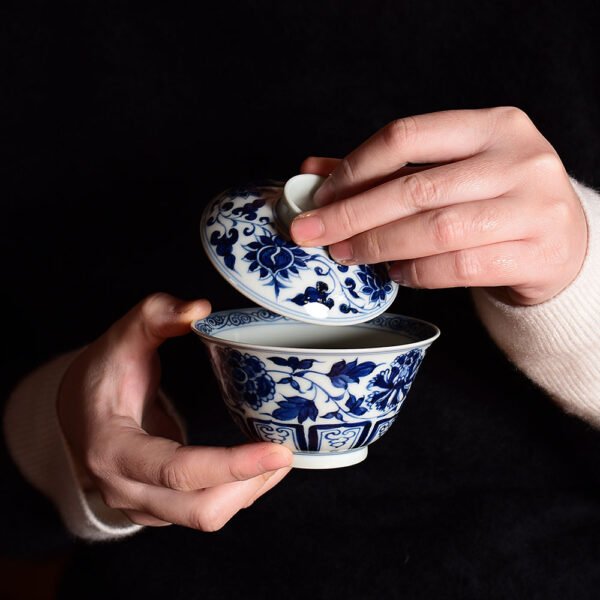
 $429.99
$429.99The style of this super beautiful Gaiwan is Ming, using the underglaze blue technique, and entirely handcrafted and hand painted. The pattern features the classic design of intertwining Peony branches.
Peony, one of the beloved traditional patterns in our country, holds a special place in the hearts of the Chinese people with its lush and vibrant appearance and striking colors. As a symbol of our national spirit, it embodies the beautiful aspirations and good wishes for life, symbolizing the prosperity and longevity of the Chinese nation, with a history that stretches far into the past. The intertwined peony, known as “Wanshou Teng” or “Peony with Entwined Branches,” is a traditional auspicious pattern, that represents joyous occasions. Its continuous interlocking structure also conveys the meaning of “endless vitality” or “continuous growth.”
In addition, the beautiful tin spots on the porcelain add even more unique charm to it. The formation of tin spots is due to the high content of iron elements in local parts of the blue pigment. After reaching saturation in the high-temperature glaze solution and cooling down, the iron elements in the supersaturated part start to precipitate. If the iron content of the blue pigment is higher and the cooling rate is appropriate, tin spots are more likely to appear on the surface of the ware.
In addition to firing and materials, the formation of tin spots also involves the factor of glaze material. During the painting process, tin spots can also be formed due to the accumulation of blue pigment. Tin spots are more likely to appear on the surface of the ware at the intersections and the starting and ending points of brushstrokes. The formation of tin spots can be said to be a natural creation or an artificial decoration. This tin glazes not only add a rustic texture to the Gaiwan but also imbue it with a unique sense of history.
This Gaiwan exudes a charming style reminiscent of imitating the essence of Yuan Dynasty tea sets.
-
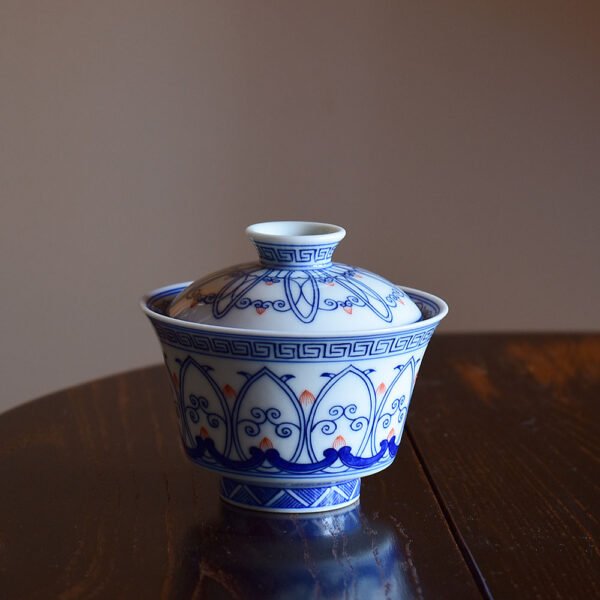
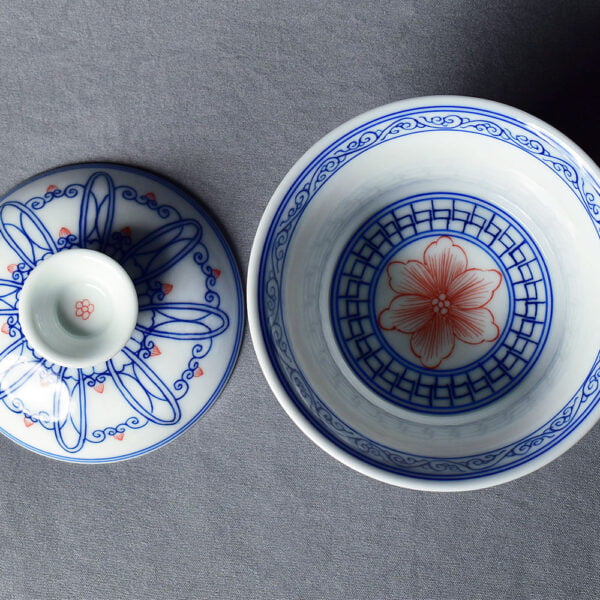 Out of Stock
$259.99
Out of Stock
$259.99This Gaiwan is completely handmade and hand-painted. The special craft used in this teaware includes Blue and white underglaze colour and underglaze red. The special horseshoe-shaped design allows for easy handling and prevents becoming too hot to touch.
The pattern featured is called “Bao Xiang” in Chinese, which is a traditional decorative motif representing one of the auspicious three treasures (Bao Xiang flower, Money tree, and Treasure basin), prevalent during the Sui and Tang dynasties in China. Bao Xiang pattern is also known as ‘Bao Xian Hua’ or ‘Bao Lian Hua’. Its lines are clear, and the colour is serene and antique. The Bao Xiang pattern design of this teaware is neat, and complex but not messy, and the whole picture of it is full and rich in details.
In Chinese culture, the Bao Xiang pattern symbolizes auspiciousness and happiness, representing people’s aspirations for happiness. It is widely popular in the decoration of silk brocade, bronze mirrors, and porcelain, showcasing people’s pursuit of a better life.
This Gaiwan features smooth and concise curves, combining the unique beauty of the Bao Xiang pattern, creating a visually appealing and enjoyable tea-drinking experience. The blue and red underglaze colours complement each other and create a beautiful radiance.
-
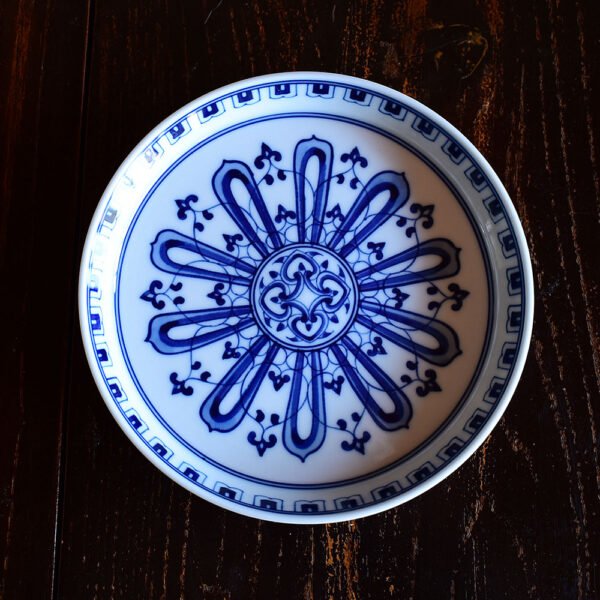
 Out of Stock
$189.99
Out of Stock
$189.99This tea tray is completely handmade and hand-painted. The pattern featured is called “Bao Xiang” in Chinese, which is a traditional decorative motif representing one of the auspicious three treasures (Bao Xiang flower, Money tree, and Treasure basin), prevalent during the Sui and Tang dynasties in China. Bao Xiang pattern is also known as ‘Bao Xian Hua’ or ‘Bao Lian Hua’. Its lines are clear, and the colour is serene and antique. The Bao Xiang pattern design of this teaware is neat, and complex but not messy, and the whole picture of it is full and rich in details.
In Chinese culture, the Bao Xiang pattern symbolizes auspiciousness and happiness, representing people’s aspirations for happiness. It is widely popular in the decoration of silk brocade, bronze mirrors, and porcelain, showcasing people’s pursuit of a better life.
This tea tray features smooth and concise curves, combining the unique beauty of the Bao Xiang pattern, creating a visually appealing and enjoyable tea-drinking experience.
-
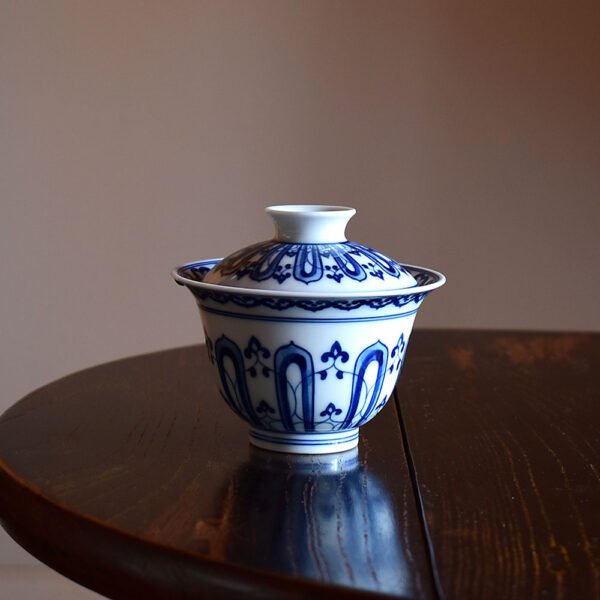
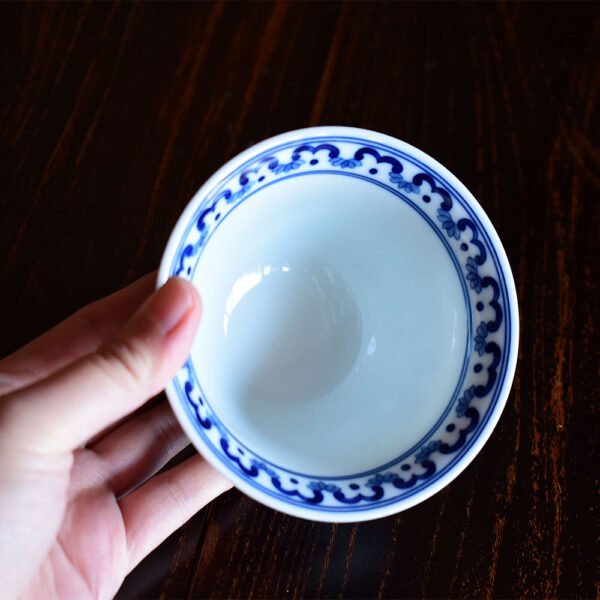 Out of Stock
$199.99
Out of Stock
$199.99This Gaiwan is completely handmade and hand-painted. The pattern featured is called “Bao Xiang” in Chinese, which is a traditional decorative motif representing one of the auspicious three treasures (Bao Xiang flower, Money tree, and Treasure basin), prevalent during the Sui and Tang dynasties in China. Bao Xiang pattern is also known as ‘Bao Xian Hua’ or ‘Bao Lian Hua’. Its lines are clear, and the colour is serene and antique. The Bao Xiang pattern design of this teaware is neat, and complex but not messy, and the whole picture of it is full and rich in details.
In Chinese culture, the Bao Xiang pattern symbolizes auspiciousness and happiness, representing people’s aspirations for happiness. It is widely popular in the decoration of silk brocade, bronze mirrors, and porcelain, showcasing people’s pursuit of a better life.
This Gaiwan features smooth and concise curves, combining the unique beauty of the Bao Xiang pattern, creating a visually appealing and enjoyable tea-drinking experience.
-
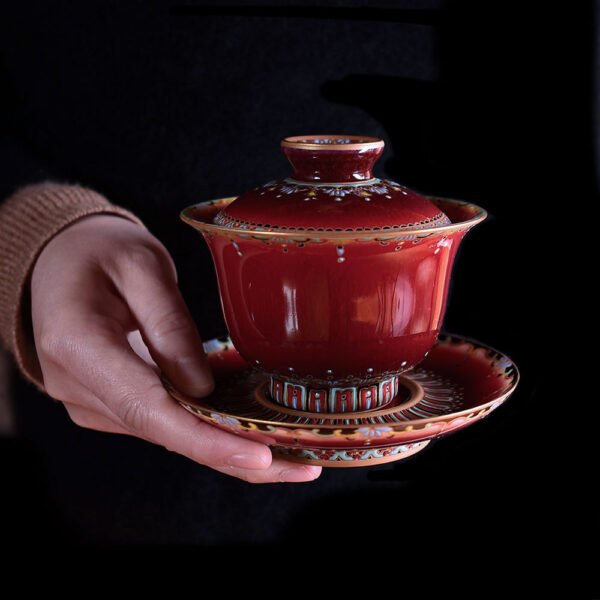
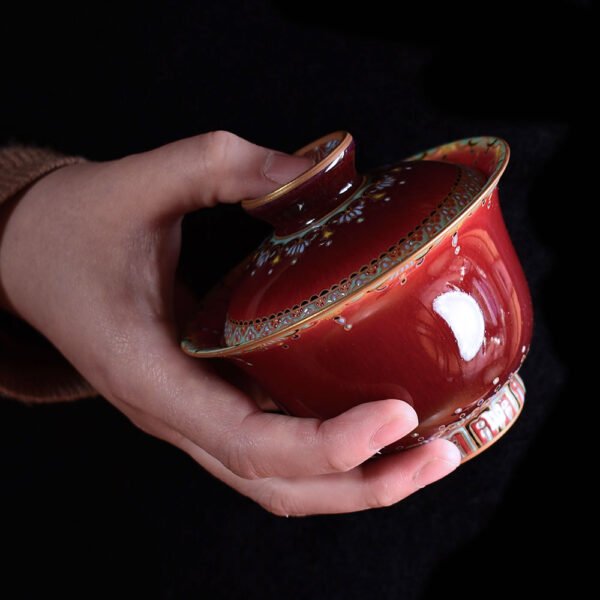 Out of Stock
$999.99[vc_row et_row_padding="true" el_class="p-variations"][vc_column width="1/3" offset="vc_col-xs-4"][et_image alignment="aligncenter" image="30470" extra_class="p-current"][/et_image][/vc_column][vc_column width="1/3" offset="vc_col-xs-4"][et_image alignment="aligncenter" image="30531" img_link="url:/p/hand-painted-lang-hong-enamel-dunhuang-gaiwan-er-cai/"][/et_image][/vc_column][vc_column width="1/3" offset="vc_col-xs-4"][/vc_column][/vc_row]
Out of Stock
$999.99[vc_row et_row_padding="true" el_class="p-variations"][vc_column width="1/3" offset="vc_col-xs-4"][et_image alignment="aligncenter" image="30470" extra_class="p-current"][/et_image][/vc_column][vc_column width="1/3" offset="vc_col-xs-4"][et_image alignment="aligncenter" image="30531" img_link="url:/p/hand-painted-lang-hong-enamel-dunhuang-gaiwan-er-cai/"][/et_image][/vc_column][vc_column width="1/3" offset="vc_col-xs-4"][/vc_column][/vc_row]This Sancai Gaiwan is handcrafted using the technique of gold painting, Lang Hong colouring and enamel glazed paint. The pattern on its painting is Dunhuang-style, with vibrant and luxurious colours, exuding a sense of luxury and elegance.
Gold painting, one of the decorative techniques, involves applying gold powder (gold dust) or bright gold (gold solution) on the porcelain surface to create intricate patterns or to complement other decorations as borders or a golden background. Afterwards, the Gaiwan is fired at a low temperature to achieve the final finish. The gold painting craftsmanship is applied in multiple areas of this Sancai Gaiwan.
The patterns on this Gaiwan depict Dunhuang-style designs, layered and intricate, displaying a rich array of colours. Among them, the lotus pattern is the most used decorative motif in Dunhuang art. From the Northern Liang to the Yuan Dynasty, lotus flowers can be found in every cave of the Mogao Grottoes. In Buddhism, the lotus symbolizes purity and enlightenment. It is believed that one’s soul can attain rebirth through the lotus, leading to the blissful Western Pure Land. Within the Mogao Grottoes, lotus flowers adorn the background, embellishing figures of bodhisattvas and celestial beings, embodying the sacred and immaculate nature of Buddhas and bodhisattvas. Hence, the lotus is the quintessential flower representing Buddhism. Apart from the lotus, another significant motif is the honeysuckle, also known as Jin Hua (golden-silver flower). It is an important decorative symbol in Dunhuang art, introduced alongside Buddhist art in China as a decorative floral theme. The rise of honeysuckle patterns in China occurred nearly simultaneously with the spread of Buddhism. Its extensive use in Buddhist decorations during the Northern Dynasties influenced secular ornamentation at that time. Honeysuckle blooms during summer, transitioning from white to yellow after budding, shedding old leaves in late autumn, and promptly producing new leaves. It endures even in the harshest winter conditions, quietly thriving in the wild with minimal requirements of water and soil. As a result, the honeysuckle pattern found abundant application in Buddhist-related decorations, drawing from its persistent growth characteristics. Furthermore, the motif of the “Baoxiang Flower,” also known as Baoxianhua or Baolianhua, is another traditional auspicious pattern in Dunhuang decorations. It is one of the auspicious Three Treasures and was prevalent during China’s Sui and Tang Dynasties. The concept of “Baoxiang” originates from Buddhism, where it refers to a respectful term for Buddhist images. The Baoxiang Flower represents an idealized form of purity, grace, and beauty.
In addition to these captivating decorative patterns, the craftsmanship of Lang Hong ceramics is also deserving of praise. Firstly, the full name of Lang Hong is “Langyao Red,” also known as “Gem Red” or “Ox Blood Red.” It is one of the most vibrant colours in traditional Chinese precious copper red glazes. Lang Hong glaze is achieved by using copper as a colouring agent and firing it at a high temperature of 1300°C. Since copper elements easily evaporate at high temperatures, the range of colour expression is limited. The firing process demands strict control over the atmosphere and temperature, and the outcome is greatly affected by external factors, making it a highly challenging process to successfully produce Lang Hong ceramics. Lang Hong glaze boasts a smooth and translucent surface, resembling glass, with crackled patterns resembling cow hair texture. The glaze exhibits a deep and vivid colour, resembling freshly congealed ox blood with its brilliant crimson hue, symbolizing auspiciousness, and wealth. Revered as a “treasure among a thousand kilns,” the red-glazed porcelain of Lang Hong showcases a distinctive ethnic style, shining like a dazzling gem in the history of world ceramics. The colour red, known for its auspiciousness and affluence, has elevated Lang Hong ceramics to a radiant and remarkable masterpiece in the realm of ceramic art.
Enamel, on the other hand, is a decorative technique that involves transplanting the cloisonné enamel method onto a porcelain body as an overglaze colour decoration. Enamel decoration on porcelain, known as “Fàlángcǎi” in Chinese, entails painting colourful patterns on the porcelain surface and then firing it at high temperatures to fuse the colours with the porcelain, achieving a durable and splendid design. These patterns often feature exquisite themes such as flowers, birds, figures, and landscapes, reflecting the essence of traditional Chinese culture and art. The process of creating enamel decorations is extremely intricate and complex, requiring skilled and experienced craftsmen. First, the porcelain prototype is made, and then special mineral pigments are used to paint patterns on its surface. Once the painting is completed, a series of firing processes follow, during which the temperature and timing for both the porcelain and the enamel colours are crucial factors. Improper temperature or timing can result in cracks in the porcelain or unstable colours. Enamel decoration is considered a treasure in traditional Chinese craftsmanship, representing the wisdom and skills of ancient Chinese artisans.
This Sancai Gaiwan showcases exquisite Lang Hong craftsmanship, with intricate and delicate Dunhuang patterns that carry profound symbolism.
-

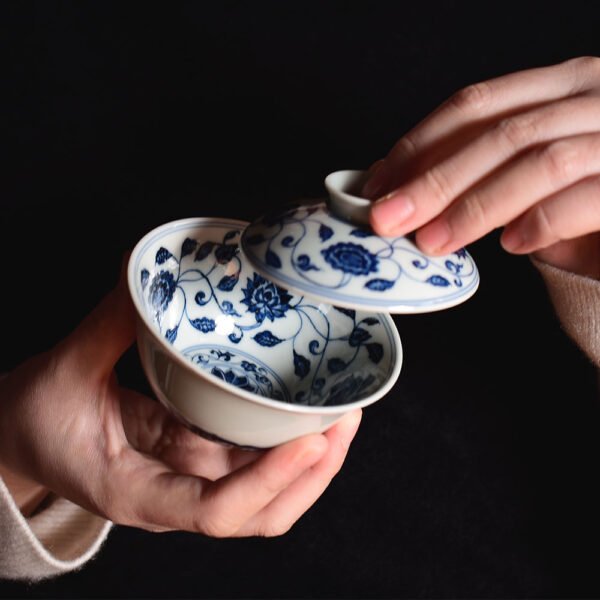 Out of Stock
$769.99
Out of Stock
$769.99The style of this super beautiful Gaiwan is Ming, using the underglaze blue technique, and entirely handcrafted and hand painted. The pattern features the classic design of intertwining lotus branches (Chanzhi Lian).
Chanzhi Lian, also known as ‘intertwining lotus branches’ or ‘Interlock Branch Lotus’, is a Chinese decorative motif with the symbolism of “flowers within flowers, blossoms within leaves.” It is also referred to as the “Wanshou Teng,” representing auspiciousness and longevity due to its continuous and interconnected structure, symbolizing the concept of “endless vitality.” In addition, in traditional Chinese Confucian culture, the lotus is seen as the embodiment of truth, goodness, and beauty, as well as a symbol of Buddhism. The pronunciation of “Lian” is similar to the word “continuous” in Chinese, further expressing the idea of continuous growth and conveying positive wishes and emotions.
As part of Chinese traditional ornamentation, Chanzhi Lian has been passed down through generations, reflecting its own beauty and cultural significance with a unique artistic charm. The lotus possesses a sacred and pure temperament, being beautiful without being ostentatious and magnificent without being vulgar. It is precisely because of this aesthetic appeal that Chanzhi Lian has become a decorative pattern applied to various aspects of life.
The Ruyi motifs on the outside of this flat-bottom Gaiwan also carry auspicious meanings. The Ruyi symbolizes auspiciousness and good fortune. Its rounded and flawless form embodies blessings, satisfaction, and wishes fulfilled. Underneath its graceful appearance, it holds profound significance, representing the auspicious and delightful ideals of good fortune and contentment.
In addition, the beautiful tin spots on the porcelain add even more unique charm to it. The formation of tin spots is due to the high content of iron elements in local parts of the blue pigment. After reaching saturation in the high-temperature glaze solution and cooling down, the iron elements in the supersaturated part start to precipitate. If the iron content of the blue pigment is higher and the cooling rate is appropriate, tin spots are more likely to appear on the surface of the ware.
In addition to firing and materials, the formation of tin spots also involves the factor of glaze material. During the painting process, tin spots can also be formed due to the accumulation of blue pigment. Tin spots are more likely to appear on the surface of the ware at the intersections and the starting and ending points of brushstrokes. The formation of tin spots can be said to be a natural creation or an artificial decoration. This tin glazes not only add a rustic texture to the Gaiwan but also imbue it with a unique sense of history.
The delicate brushstrokes and intricate detailing of the painting on this Gaiwan create a distinct sense of aesthetic appeal. The stunning underglaze blue, along with the heavy tin glaze, gives it a bold and intense beauty. This Gaiwan exudes a simple yet luxuriant charm, reminiscent of the style of imitation Ming, making it truly captivating and irresistible.
-
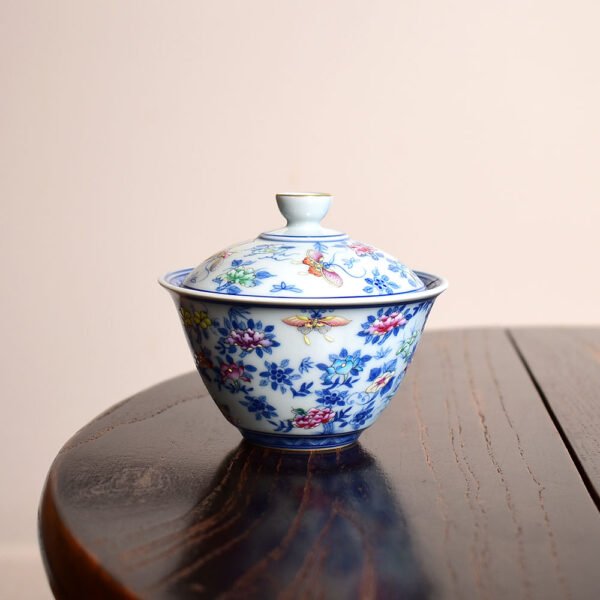
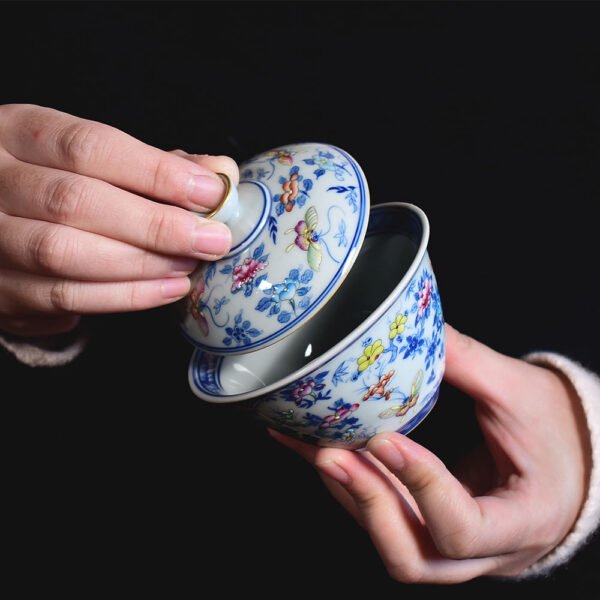 Out of Stock
$999.99
Out of Stock
$999.99This Gaiwan is handcrafted using the technique of Blue-and-white underglaze colour and enamel glazed painting. The design features a pattern of butterflies amid flowers, displaying rich and lifelike colours, creating a unique and charming ambiance.
Blue and White Enamel is a distinctive porcelain decoration technique that combines the traditional methods of blue and white with enamel. It is a variation of the traditional Chinese porcelain production, blending the characteristics of blue and white with enamel, resulting in a captivating and unique decorative style.
Blue and White refers to the technique of painting blue patterns on the porcelain surface. It originated during the Yuan dynasty but reached its peak during the Ming and Qing dynasties. This decorative method uses cobalt oxide blue pigments that fuse with the porcelain surface at high temperatures, ensuring the patterns’ durability.
Enamel, on the other hand, is a decorative technique that involves transplanting the cloisonné enamel method onto a porcelain body as an overglaze colour decoration. Enamel decoration on porcelain, known as “Fàlángcǎi” in Chinese, entails painting colourful patterns on the porcelain surface and then firing it at high temperatures to fuse the colours with the porcelain, achieving a durable and splendid design. These patterns often feature exquisite themes such as flowers, birds, figures, and landscapes, reflecting the essence of traditional Chinese culture and art.
The process of creating enamel decorations is extremely intricate and complex, requiring skilled and experienced craftsmen. First, the porcelain prototype is made, and then special mineral pigments are used to paint patterns on its surface. Once the painting is completed, a series of firing processes follow, during which the temperature and timing for both the porcelain and the enamel colours are crucial factors. Improper temperature or timing can result in cracks in the porcelain or unstable colours. Enamel decoration is considered a treasure in traditional Chinese craftsmanship, representing the wisdom and skills of ancient Chinese artisans.
The combination of blue and white enamel unites these two techniques, typically starting with the blue and white technique to depict blue patterns, and then applying enamel decoration to add additional colours and enhance the visual effect and three-dimensional sense of the design. This decorative method enriches the patterns on the porcelain while preserving the distinctive features of both blue and white and enamel techniques. During the Ming and Qing dynasties, blue and white enamel reached its peak and became one of the main styles for porcelain decoration at that time.
The design of this Gaiwan showcases lifelike patterns of butterflies amid flowers. “Butterflies in Love with Flowers” symbolizes sweet love and blissful marriage. In recent times, people have endowed this motif with more profound meanings, expressing good wishes and symbolizing beautiful and prosperous love. Butterflies are often seen as symbols of happiness and love, inspiring and captivating people’s imagination, and aspirations. In traditional Chinese literature, a pair of flying butterflies represents the pursuit of free and passionate love. Butterflies are loyal to their mates, having only one partner throughout their lives, making them a symbol of fidelity in the insect world. Moreover, there is a beautiful Chinese folktale known as “The Butterfly Lovers,” which further enhances the symbolism of sweet love and harmonious marriage associated with the motif of butterflies and flowers.
This enamel-decorated Gaiwan displays a rich and colourful palette, with lively and dynamic brushstrokes, immersing people in an elegant artistic ambiance while enjoying their tea.
-
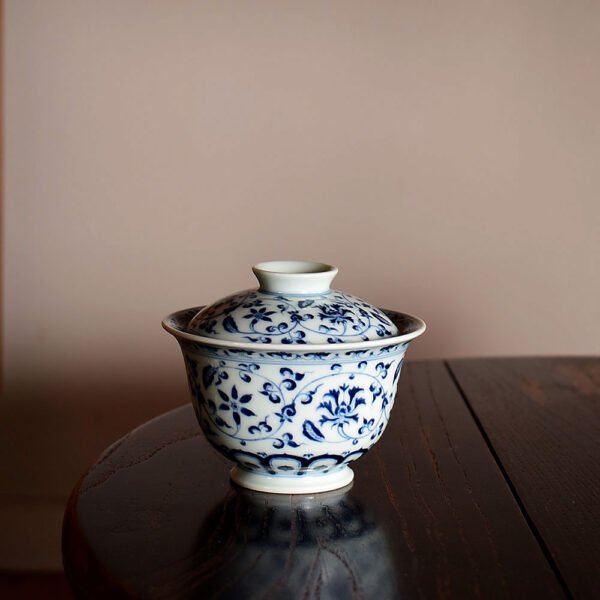
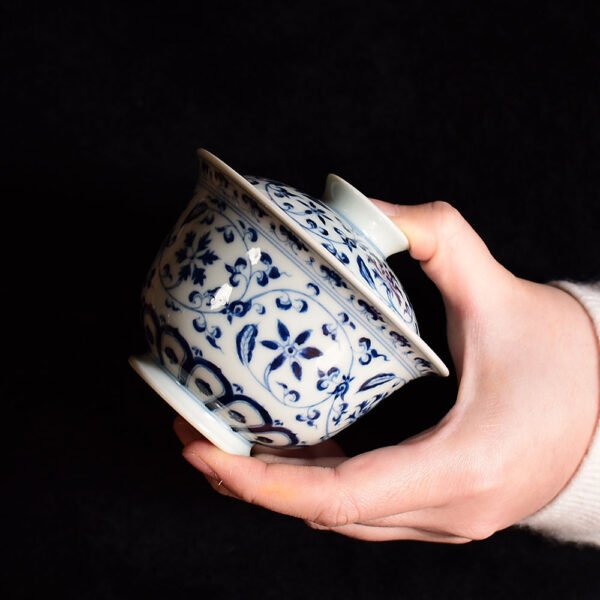 $899.99
$899.99The style of this super beautiful Gaiwan is Ming, using the underglaze blue technique, and entirely handcrafted and hand painted. The pattern features the classic design of intertwining lotus branches (Chanzhi Lian).
Chanzhi Lian, also known as ‘intertwining lotus branches’ or ‘Interlock Branch Lotus’, is a Chinese decorative motif with the symbolism of “flowers within flowers, blossoms within leaves.” It is also referred to as the “Wanshou Teng,” representing auspiciousness and longevity due to its continuous and interconnected structure, symbolizing the concept of “endless vitality.” In addition, in traditional Chinese Confucian culture, the lotus is seen as the embodiment of truth, goodness, and beauty, as well as a symbol of Buddhism. The pronunciation of “Lian” is similar to the word “continuous” in Chinese, further expressing the idea of continuous growth and conveying positive wishes and emotions.
As part of Chinese traditional ornamentation, Chanzhi Lian has been passed down through generations, reflecting its own beauty and cultural significance with a unique artistic charm. The lotus possesses a sacred and pure temperament, being beautiful without being ostentatious and magnificent without being vulgar. It is precisely because of this aesthetic appeal that Chanzhi Lian has become a decorative pattern applied to various aspects of life.
In addition, the beautiful tin spots on the porcelain add even more unique charm to it. The formation of tin spots is due to the high content of iron elements in local parts of the blue pigment. After reaching saturation in the high-temperature glaze solution and cooling down, the iron elements in the supersaturated part start to precipitate. If the iron content of the blue pigment is higher and the cooling rate is appropriate, tin spots are more likely to appear on the surface of the ware.
In addition to firing and materials, the formation of tin spots also involves the factor of glaze material. During the painting process, tin spots can also be formed due to the accumulation of blue pigment. Tin spots are more likely to appear on the surface of the ware at the intersections and the starting and ending points of brushstrokes. The formation of tin spots can be said to be a natural creation or an artificial decoration. This tin glazes not only add a rustic texture to the Gaiwan but also imbue it with a unique sense of history.
The delicate brushstrokes and intricate detailing of the painting on this Gaiwan create a distinct sense of aesthetic appeal. The soft and elegant shade of underglaze blue, along with a hint of faint tin glaze, gives it a graceful and ethereal beauty under the light. This Gaiwan exudes a simple yet elegant charm, reminiscent of the style of imitation Ming, making it truly captivating and irresistible.
-
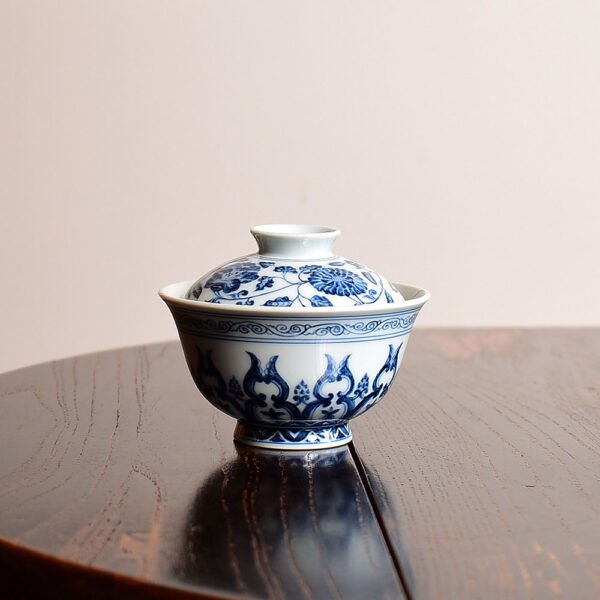
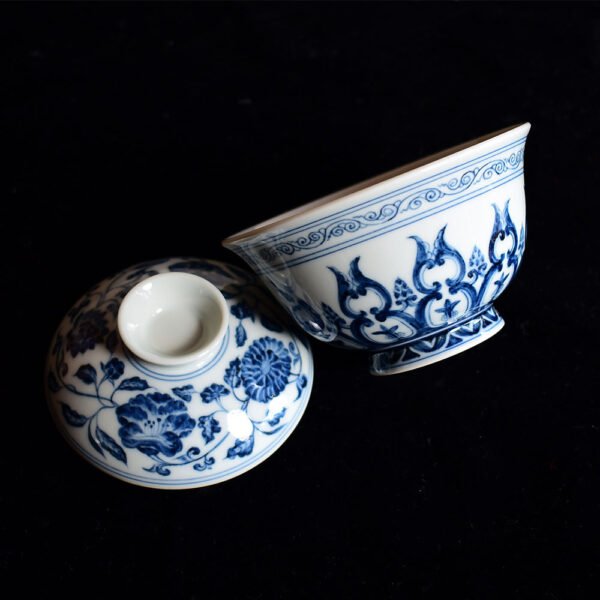 Out of Stock
$769.99[vc_row et_row_padding="true" el_class="p-variations"][vc_column width="1/3" offset="vc_col-xs-4"][et_image alignment="aligncenter" image="30301" img_link="url:/p/hand-painted-twin-lotus-gaiwan-tall/"][/et_image][/vc_column][vc_column width="1/3" offset="vc_col-xs-4"][et_image alignment="aligncenter" image="30274" extra_class="p-current"][/et_image][/vc_column][vc_column width="1/3" offset="vc_col-xs-4"][/vc_column][/vc_row]
Out of Stock
$769.99[vc_row et_row_padding="true" el_class="p-variations"][vc_column width="1/3" offset="vc_col-xs-4"][et_image alignment="aligncenter" image="30301" img_link="url:/p/hand-painted-twin-lotus-gaiwan-tall/"][/et_image][/vc_column][vc_column width="1/3" offset="vc_col-xs-4"][et_image alignment="aligncenter" image="30274" extra_class="p-current"][/et_image][/vc_column][vc_column width="1/3" offset="vc_col-xs-4"][/vc_column][/vc_row]The style of this super beautiful Gaiwan is Ming, using the underglaze blue technique, and entirely handcrafted and hand painted. The pattern on the lid features a classic design of intertwining lotus branches (known as Chanzhi Lian), while the pattern on the body of Gaiwan showcases the traditional Chinese twin lotus motif. The design of the tall style with an outward-flared mouth extends the curvature of the Gaiwan, making it less likely to scald one’s hand during use. The short style, on the other hand, is delicate and compact, with a thicker body, suitable for tea drinkers with smaller hands.
In ancient China, the twin lotus due to its symbolic meaning is regarded as the gentleman among flowers. It represents the finest specimen among lotus flowers and symbolises a harmonious and everlasting union. The twin lotus, with one stem and two blooms, epitomizes the notion of unity, shared roots, shared blessings, and shared existence. Besides that, in ancient literary works, the twin lotus is acclaimed as a symbol of love, conveying the message of marital harmony, happiness, and representing the tender affection between lovers. It is also associated with deep brotherly love, signifying profound emotional bonds between siblings. In folklore, the appearance of twin lotus is considered an auspicious sign of good fortune.
In addition, the beautiful tin spots on the porcelain add even more unique charm to it. The formation of tin spots is due to the high content of iron elements in local parts of the blue pigment. After reaching saturation in the high-temperature glaze solution and cooling down, the iron elements in the supersaturated part start to precipitate. If the iron content of the blue pigment is higher and the cooling rate is appropriate, tin spots are more likely to appear on the surface of the ware.
In addition to firing and materials, the formation of tin spots also involves the factor of glaze material. During the painting process, tin spots can also be formed due to the accumulation of blue pigment. Tin spots are more likely to appear on the surface of the ware at the intersections and the starting and ending points of brushstrokes. The formation of tin spots can be said to be a natural creation or an artificial decoration. This tin glazes not only add a rustic texture to the Gaiwan but also imbue it with a unique sense of history.
The delicate brushstrokes and intricate detailing of the painting on this Gaiwan create a distinct sense of aesthetic appeal. The soft and elegant shade of underglaze blue, along with a hint of faint tin glaze, gives it a graceful and ethereal beauty under the light. This Gaiwan exudes a simple yet elegant charm, reminiscent of the style of imitation Ming, making it truly captivating and irresistible.
-
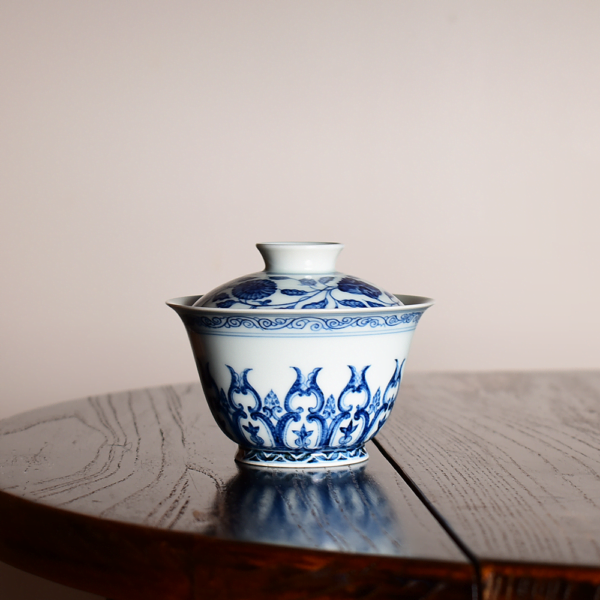
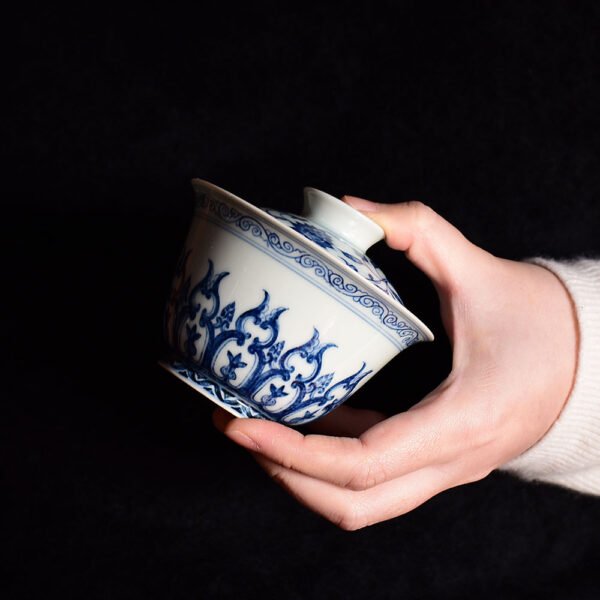 Out of Stock
$769.99[vc_row et_row_padding="true" el_class="p-variations"][vc_column width="1/3" offset="vc_col-xs-4"][et_image alignment="aligncenter" image="30301" extra_class="p-current"][/et_image][/vc_column][vc_column width="1/3" offset="vc_col-xs-4"][et_image alignment="aligncenter" image="30274" img_link="url:%2Fp%2Fhand-painted-twin-lotus-gaiwan-short%2F"][/et_image][/vc_column][vc_column width="1/3" offset="vc_col-xs-4"][/vc_column][/vc_row]
Out of Stock
$769.99[vc_row et_row_padding="true" el_class="p-variations"][vc_column width="1/3" offset="vc_col-xs-4"][et_image alignment="aligncenter" image="30301" extra_class="p-current"][/et_image][/vc_column][vc_column width="1/3" offset="vc_col-xs-4"][et_image alignment="aligncenter" image="30274" img_link="url:%2Fp%2Fhand-painted-twin-lotus-gaiwan-short%2F"][/et_image][/vc_column][vc_column width="1/3" offset="vc_col-xs-4"][/vc_column][/vc_row]The style of this super beautiful Gaiwan is Ming, using the underglaze blue technique, and entirely handcrafted and hand painted. The pattern on the lid features a classic design of intertwining lotus branches (known as Chanzhi Lian), while the pattern on the body of Gaiwan showcases the traditional Chinese twin lotus motif. The design of the tall style with an outward-flared mouth extends the curvature of the Gaiwan, making it less likely to scald one’s hand during use. The short style, on the other hand, is delicate and compact, with a thicker body, suitable for tea drinkers with smaller hands.
In ancient China, the twin lotus due to its symbolic meaning is regarded as the gentleman among flowers. It represents the finest specimen among lotus flowers and symbolises a harmonious and everlasting union. The twin lotus, with one stem and two blooms, epitomizes the notion of unity, shared roots, shared blessings, and shared existence. Besides that, in ancient literary works, the twin lotus is acclaimed as a symbol of love, conveying the message of marital harmony, happiness, and representing the tender affection between lovers. It is also associated with deep brotherly love, signifying profound emotional bonds between siblings. In folklore, the appearance of twin lotus is considered an auspicious sign of good fortune.
In addition, the beautiful tin spots on the porcelain add even more unique charm to it. The formation of tin spots is due to the high content of iron elements in local parts of the blue pigment. After reaching saturation in the high-temperature glaze solution and cooling down, the iron elements in the supersaturated part start to precipitate. If the iron content of the blue pigment is higher and the cooling rate is appropriate, tin spots are more likely to appear on the surface of the ware.
In addition to firing and materials, the formation of tin spots also involves the factor of glaze material. During the painting process, tin spots can also be formed due to the accumulation of blue pigment. Tin spots are more likely to appear on the surface of the ware at the intersections and the starting and ending points of brushstrokes. The formation of tin spots can be said to be a natural creation or an artificial decoration. This tin glazes not only add a rustic texture to the Gaiwan but also imbue it with a unique sense of history.
The delicate brushstrokes and intricate detailing of the painting on this Gaiwan create a distinct sense of aesthetic appeal. The soft and elegant shade of underglaze blue, along with a hint of faint tin glaze, gives it a graceful and ethereal beauty under the light. This Gaiwan exudes a simple yet elegant charm, reminiscent of the style of imitation Ming, making it truly captivating and irresistible.
-

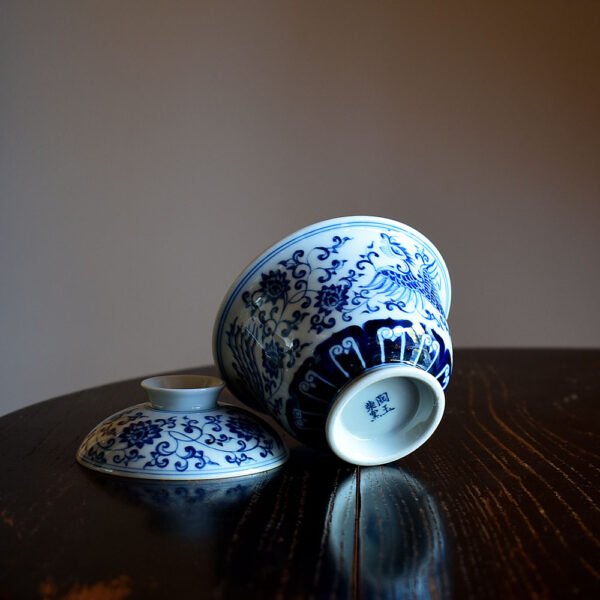 $520.99
$520.99This charming Gaiwan is using blue and white porcelain craftsmanship, made entirely by hand.
One of the patterns depicts a pair of phoenixes. The phoenix, known as the “Fenghuang” in Chinese, is a mythical bird considered to be the king of all birds and a symbol of auspiciousness, beauty, and grace. It represents virtue, harmony, and the union of yin and yang. When depicted as a pair, the double phoenix symbolizes the ideal relationship between a male and a female. It represents the union of two exceptional individuals or the coming together of two extraordinary things. It signifies a harmonious and balanced partnership, whether in love, marriage, or any collaborative endeavour. The double phoenix is often associated with blessings, prosperity, and good fortune. It is believed to bring luck, happiness, and success, as well as symbolize marital bliss, loyalty, and everlasting love.
Another pattern used on this Gaiwan is Chanzhi Lian. Chanzhi Lian, also known as “Interlock Branch Lotus,” is a Chinese decorative motif with the symbolism of “flowers within flowers, blossoms within leaves.” It is also referred to as the “Wanshou Teng,” representing auspiciousness and longevity due to its continuous and interconnected structure, symbolizing the concept of “endless vitality.” In addition, in traditional Chinese Confucian culture, the lotus is seen as the embodiment of truth, goodness, and beauty, as well as a symbol of Buddhism. The pronunciation of “Lian” is similar to the word “continuous” in Chinese, further expressing the idea of continuous growth and conveying positive wishes and emotions.
As part of Chinese traditional ornamentation, Chanzhi Lian has been passed down through generations, reflecting its own beauty and cultural significance with a unique artistic charm. The lotus possesses a sacred and pure temperament, being beautiful without being ostentatious and magnificent without being vulgar. It is precisely because of this aesthetic appeal that Chanzhi Lian has become a decorative pattern applied to various aspects of life.
The texture of this Gaiwan is delicate and smooth, and the painting is lively and lifelike. The entire production process is completed by hand, with every detail carefully designed and polished, giving this Gaiwan a unique artistic charm. This tea ware by imitating the shape and style of traditional Chinese tea ware, allowing people to appreciate the charm of traditional art and experience the flavour of history. The elegant lines, smooth curves, and delicate decorations present a sense of refined and harmonious beauty, allowing people to experience pleasure and artistic enjoyment while tasting tea.
-
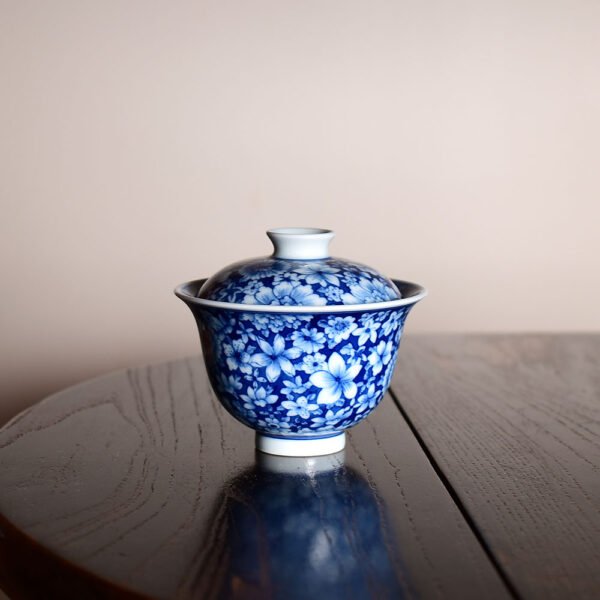
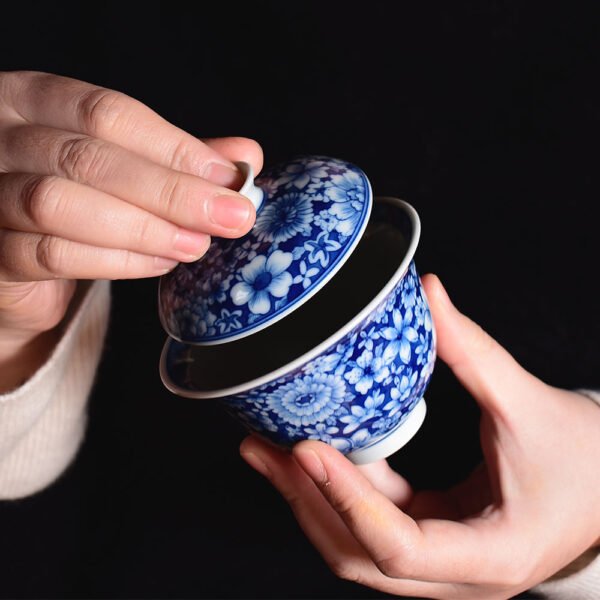 $389.99
$389.99This charming Gaiwan is using blue and white porcelain craftsmanship, made entirely by hand.
The beautiful picture on the body of Gaiwan is called ‘Wan Hua’, also known as “myriad flowers,” “flowers on top of flowers,” or “adding flowers to enhance beauty,” is commonly depicted in the central area of the object. It often features large patterns of peonies, surrounded by various smaller floral patterns such as chrysanthemums, camellia, roses, lotuses, lilies, morning glories, and others. The intricate secondary patterns cover the entire surface, symbolizing the gathering of myriad flowers and representing prosperity and harmony.
The delicate brushstrokes vividly outline the different flowers, creating a glossy and elegant appearance. The colours are rich and vibrant, giving the piece a sense of vivid and liveliness.
Note: All are fully handmade, every Gaiwan can be slightly different.
-
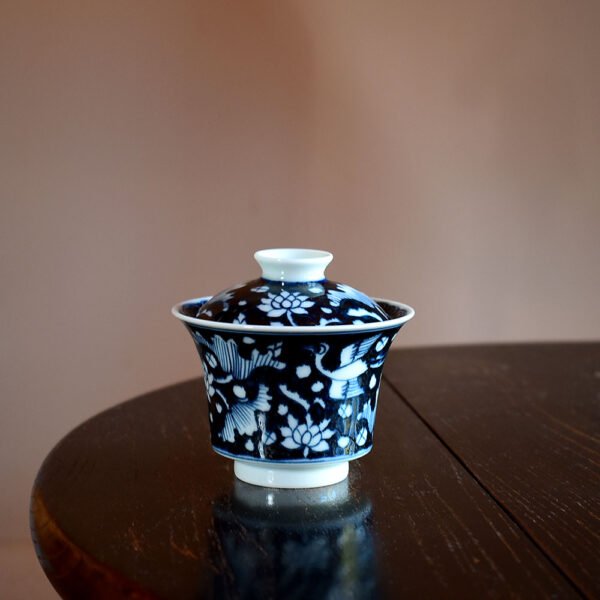
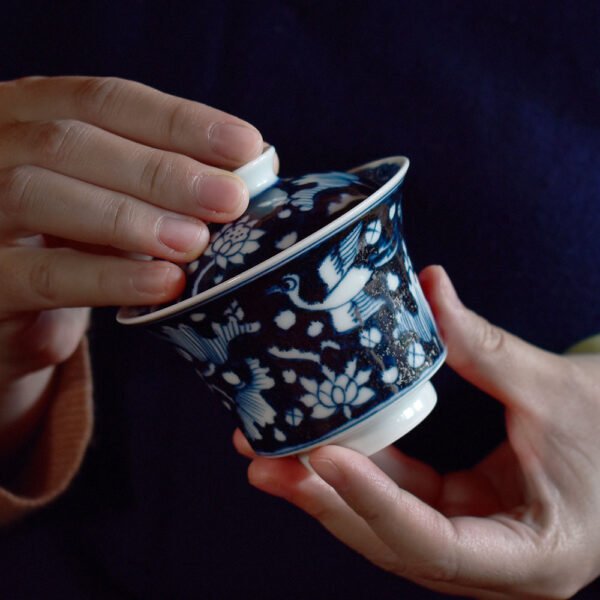 $279.99
$279.99This Gaiwan is made in the style of the Yuan dynasty blue and white porcelain, completely handmade and hand-painted. The pattern of “一鹭莲科” or “一路连科” in Chinese culture is derived from the beautiful combination of the heron and lotus leaves. As “鹭” (heron) and “路” (path/road) have the same pronunciation, and “莲” (lotus) sounds like “连” (successive/continuous), the name “一路连科” is a play on words that conveys the beautiful meaning of the pattern. In ancient times, successive successful candidates in the imperial examinations were called “连科,” and “一路连科” is a good wish for students to have a smooth career path and achieve success step by step.
For Yuan blue and white porcelain refers to the blue and white porcelain produced during the Yuan dynasty (1271-1368) in China. The Yuan dynasty was an important period in the history of Chinese porcelain and one of the peaks of Chinese porcelain art. As one of the representatives of that era, Yuan blue and white porcelain exhibited unique artistic styles and technical levels. The characteristic of Yuan blue and white is the use of cobalt blue pigment for painting, which is made of cobalt oxide. After firing, the colour is bright and rich, with an extremely high decorative effect. Yuan blue and white porcelain has various shapes, thick and heavy, concise, and fluent lines, and stable and solemn shapes, all made exquisitely.
The evolution of Yuan blue and white is based on the foundation of the Tang and Song celadon. Firstly, the glaze colour was improved and innovated. Unique white glaze, eggshell glaze and blue-white glaze were invented to make the glaze crystal clear. Cobalt pigment was imported for glaze colouring. Or using pigment made from domestic materials.
The formation of tin spots on Yuan blue and white is due to the high content of iron elements in local parts of the blue pigment. After reaching saturation in the high-temperature glaze solution and cooling down, the iron elements in the supersaturated part start to precipitate. If the iron content of the blue pigment is higher and the cooling rate is appropriate, tin spots are more likely to appear on the surface of the ware.
In addition to firing and materials, the formation of tin spots also involves the factor of glaze material. During the painting process, tin spots can also be formed due to the accumulation of blue pigment. Tin spots are more likely to appear on the surface of the ware at the intersections and the starting and ending points of brushstrokes. The formation of tin spots can be said to be a natural creation or an artificial decoration.
This Gaiwan has a thick body and uses the Su Ma Li Qing glaze material (a kind of blue pigment), with a heavy sense of tin spots, revealing a unique charm of the past era. The entire production process is completed by hand, and every detail has been carefully designed and polished, giving this Gaiwan a unique artistic charm.
-
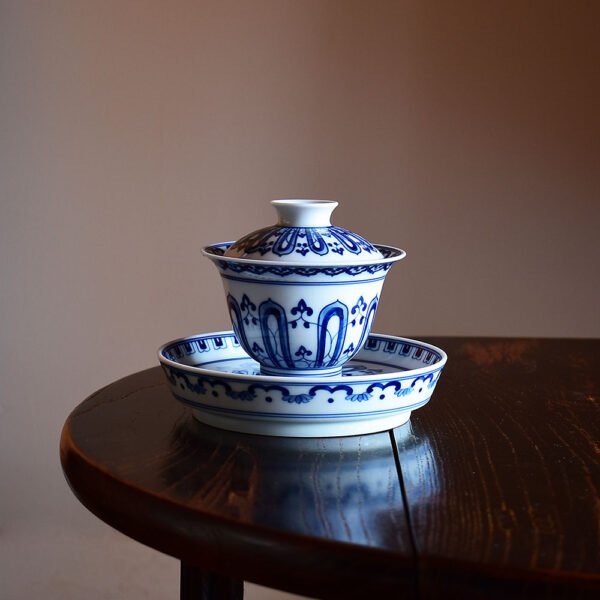
 From: $389.98
From: $389.98This tea set is completely handmade and hand-painted. The pattern featured is called “Bao Xiang” in Chinese, which is a traditional decorative motif representing one of the auspicious three treasures (Bao Xiang flower, Money tree, and Treasure basin), prevalent during the Sui and Tang dynasties in China. Bao Xiang pattern is also known as ‘Bao Xian Hua’ or ‘Bao Lian Hua’. Its lines are clear, and the colour is serene and antique. The Bao Xiang pattern design of this teaware is neat, and complex but not messy, and the whole picture of it is full and rich in details.
In Chinese culture, the Bao Xiang pattern symbolizes auspiciousness and happiness, representing people’s aspirations for happiness. It is widely popular in the decoration of silk brocade, bronze mirrors, and porcelain, showcasing people’s pursuit of a better life.
This tea set features smooth and concise curves, combining the unique beauty of the Bao Xiang pattern, creating a visually appealing and enjoyable tea-drinking experience.
This tea set includes:
-
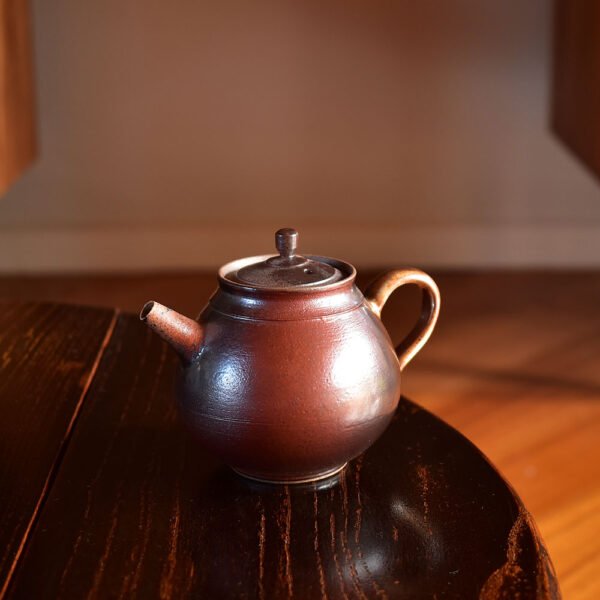
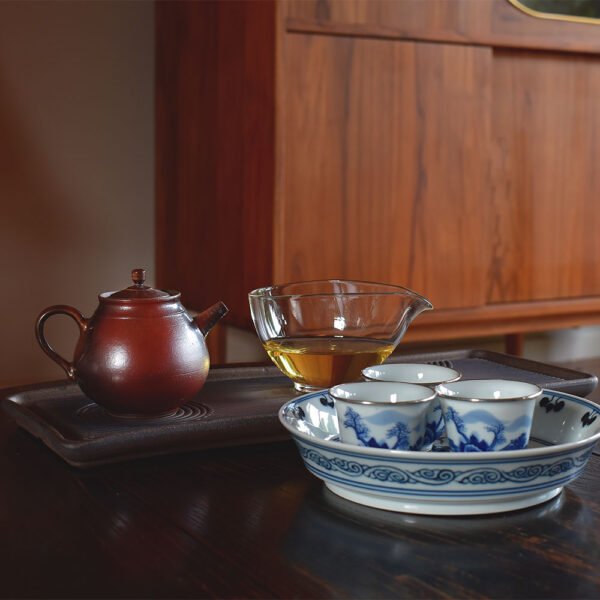 Out of Stock
$123.99[vc_row et_row_padding="true" el_class="p-variations"][vc_column width="1/3" offset="vc_col-xs-4"][et_image alignment="aligncenter" image="29756" img_link="url:%2Fp%2Fhandmade-wood-fired-beauty-teapot-round%2F"][/et_image][/vc_column][vc_column width="1/3" offset="vc_col-xs-4"][et_image alignment="aligncenter" image="29750" extra_class="p-current"][/et_image][/vc_column][vc_column width="1/3" offset="vc_col-xs-4"][/vc_column][/vc_row]
Out of Stock
$123.99[vc_row et_row_padding="true" el_class="p-variations"][vc_column width="1/3" offset="vc_col-xs-4"][et_image alignment="aligncenter" image="29756" img_link="url:%2Fp%2Fhandmade-wood-fired-beauty-teapot-round%2F"][/et_image][/vc_column][vc_column width="1/3" offset="vc_col-xs-4"][et_image alignment="aligncenter" image="29750" extra_class="p-current"][/et_image][/vc_column][vc_column width="1/3" offset="vc_col-xs-4"][/vc_column][/vc_row]Stoneware clay wood-fired teapots are handcrafted, which means that each piece is unique. And it has a unique beauty that comes from both the nature of the materials used and the firing process.
Stoneware clay is a type of ceramic clay that has a naturally earthy and organic appearance. It is often chosen by potters for its ability to give a warm and rustic feel to their work. When combined with the natural effects of wood-firing, the teapot can have a very distinct and beautiful appearance.
This unique teapot can be an impressive beauty and enjoyment when experiencing tea tasting ceremony.
-
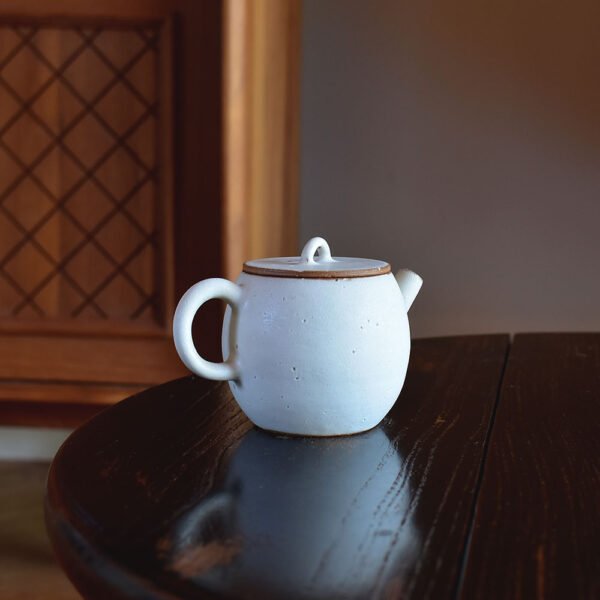
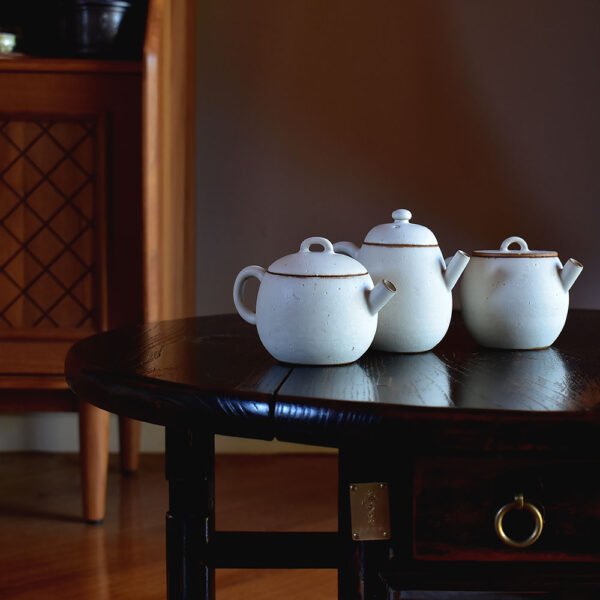 Out of Stock
$149.99[vc_row et_row_padding="true" el_class="p-variations"][vc_column width="1/3" offset="vc_col-xs-4"][et_image alignment="aligncenter" image="29663" img_link="url:%2Fp%2Fstoneware-clay-powder-sprinkling-small-teapot-tall%2F"][/et_image][/vc_column][vc_column width="1/3" offset="vc_col-xs-4"][et_image alignment="aligncenter" image="29660" extra_class="p-current"][/et_image][/vc_column][vc_column width="1/3" offset="vc_col-xs-4"][et_image alignment="aligncenter" image="29657" img_link="url:%2Fp%2Fstoneware-clay-powder-sprinkling-small-teapot-short%2F"][/et_image][/vc_column][/vc_row]
Out of Stock
$149.99[vc_row et_row_padding="true" el_class="p-variations"][vc_column width="1/3" offset="vc_col-xs-4"][et_image alignment="aligncenter" image="29663" img_link="url:%2Fp%2Fstoneware-clay-powder-sprinkling-small-teapot-tall%2F"][/et_image][/vc_column][vc_column width="1/3" offset="vc_col-xs-4"][et_image alignment="aligncenter" image="29660" extra_class="p-current"][/et_image][/vc_column][vc_column width="1/3" offset="vc_col-xs-4"][et_image alignment="aligncenter" image="29657" img_link="url:%2Fp%2Fstoneware-clay-powder-sprinkling-small-teapot-short%2F"][/et_image][/vc_column][/vc_row]This stoneware clay powder sprinkling teapot is entirely handmade. Its appearance presents a rough feeling which is its own unique beauty.
Its special technique -powder sprinkling (‘Fenyin’ in Chinese) also known as “powder blowing”, is named after its appearance resembling a gust of powder blown up by the wind. The characteristic of powder sprinkling is that the traces of its past use gradually change over time. The surface of powder sprinkling has many pores, and once water enters, those traces will unfold like petals. Rustic, understated, and inclusive, these are its features of it. Placed on a tea table, it always exudes a light sense of tranquillity and warmth.
-
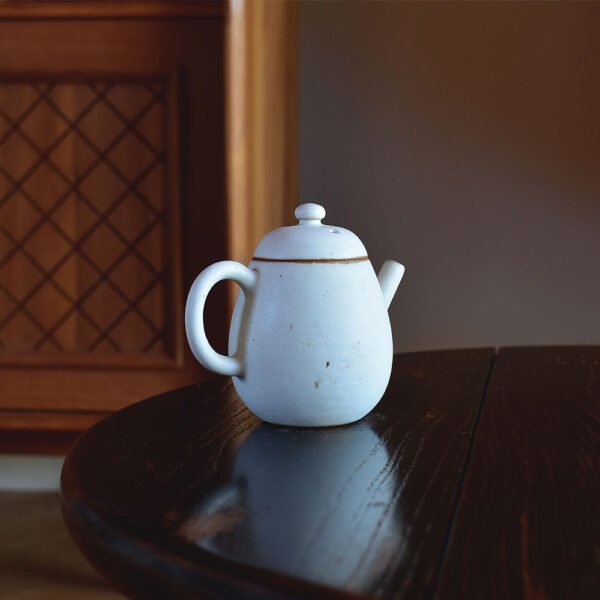
 Out of Stock
$149.99[vc_row et_row_padding="true" el_class="p-variations"][vc_column width="1/3" offset="vc_col-xs-4"][et_image alignment="aligncenter" image="29663" extra_class="p-current"][/et_image][/vc_column][vc_column width="1/3" offset="vc_col-xs-4"][et_image alignment="aligncenter" image="29660" img_link="url:%2Fp%2Fstoneware-clay-powder-sprinkling-small-teapot-flat%2F"][/et_image][/vc_column][vc_column width="1/3" offset="vc_col-xs-4"][et_image alignment="aligncenter" image="29657" img_link="url:%2Fp%2Fstoneware-clay-powder-sprinkling-small-teapot-short%2F"][/et_image][/vc_column][/vc_row]
Out of Stock
$149.99[vc_row et_row_padding="true" el_class="p-variations"][vc_column width="1/3" offset="vc_col-xs-4"][et_image alignment="aligncenter" image="29663" extra_class="p-current"][/et_image][/vc_column][vc_column width="1/3" offset="vc_col-xs-4"][et_image alignment="aligncenter" image="29660" img_link="url:%2Fp%2Fstoneware-clay-powder-sprinkling-small-teapot-flat%2F"][/et_image][/vc_column][vc_column width="1/3" offset="vc_col-xs-4"][et_image alignment="aligncenter" image="29657" img_link="url:%2Fp%2Fstoneware-clay-powder-sprinkling-small-teapot-short%2F"][/et_image][/vc_column][/vc_row]This stoneware clay powder sprinkling teapot is entirely handmade. Its appearance presents a rough feeling which is its own unique beauty.
Its special technique -powder sprinkling (‘Fenyin’ in Chinese) also known as “powder blowing”, is named after its appearance resembling a gust of powder blown up by the wind. The characteristic of powder sprinkling is that the traces of its past use gradually change over time. The surface of powder sprinkling has many pores, and once water enters, those traces will unfold like petals. Rustic, understated, and inclusive, these are its features of it. Placed on a tea table, it always exudes a light sense of tranquillity and warmth.
-
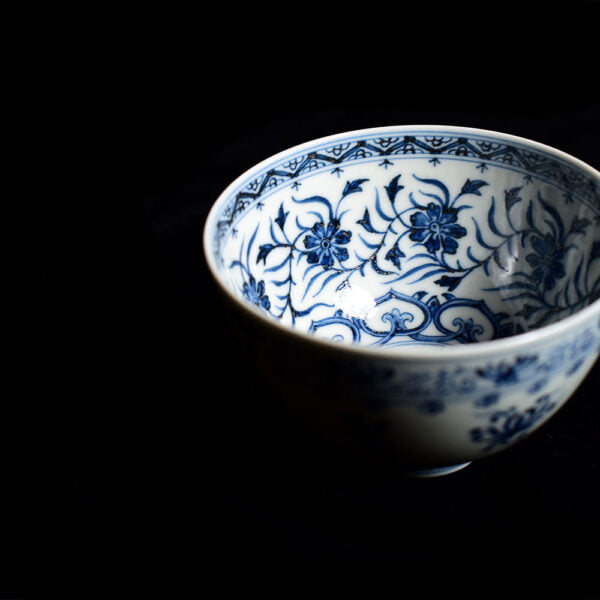
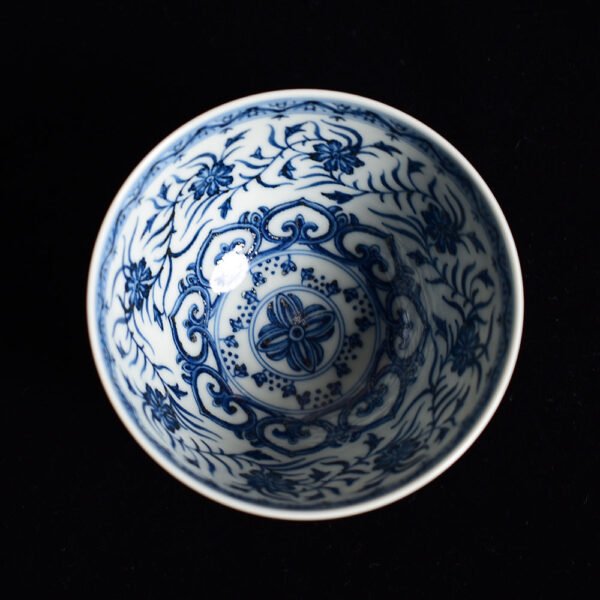 $645.99
$645.99The style of this super beautiful teacup is Ming, using the underglaze blue technique, and entirely handcrafted and hand painted.
This cup is adorned with intricate blue and white patterns of interwoven branches and miscellaneous treasures (Za Bao in Chinese) on the outer wall, with a lotus petal pattern encircling the base. The interior of the cup is fully covered in blue and white patterns of Baoxiang flowers and Ruyi motifs, creating an overall design that is rich and detailed, with smooth and flowing lines. The blue and white colours are deep and elegant, with a white glaze featuring subtle flashes of blue. The glaze surface is glossy, and the texture is smooth. The cup has a lightweight and elegant shape, achieving a harmonious balance between practicality and aesthetics. At the bottom, there is a chicken-heart-shaped protrusion, hence the name ‘chicken-heart teacup’.
In ancient China, the intertwined branch pattern represented the concept of endless growth and lasting wealth and prosperity, symbolizing longevity, and prosperity. And the miscellaneous treasures (Za Bao in Chinese) pattern symbolizes various decorative motifs that bring good luck and auspiciousness. Due to the absence of a fixed number and combination of elements, it is commonly known as the “miscellaneous treasures” pattern. The miscellaneous treasures pattern encompasses the common aspirations of society for power, wealth, love, happiness, longevity, and pleasure, making it a popular and cherished design in folk art.
The Baoxiang flowers inside the cup symbolize good luck, harmony, happiness, and prosperity. The Ruyi motif’s auspiciousness, combining profound meaning with graceful form, represents the auspicious, favourable implications.
In addition, the beautiful tin spots on the porcelain add even more unique charm to it. The formation of tin spots is due to the high content of iron elements in local parts of the blue pigment. After reaching saturation in the high-temperature glaze solution and cooling down, the iron elements in the supersaturated part start to precipitate. If the iron content of the blue pigment is higher and the cooling rate is appropriate, tin spots are more likely to appear on the surface of the ware.
In addition to firing and materials, the formation of tin spots also involves the factor of glaze material. During the painting process, tin spots can also be formed due to the accumulation of blue pigment. Tin spots are more likely to appear on the surface of the ware at the intersections and the starting and ending points of brushstrokes. The formation of tin spots can be said to be a natural creation or an artificial decoration. This tin glazes not only add a rustic texture to the teacup but also imbue it with a unique sense of history.
The body of this teacup is smooth and well-lubricated, while the underglaze blue patterns are vivid and lifelike. The faint tin specks add a touch of charm from a bygone era, evoking a sense of nostalgia and natural beauty, making it exquisitely graceful. Each stroke of the underglaze blue decoration is delicate and captivating, bringing the design to life. The intricate and refined patterns showcase the artist’s profound artistic skills.
-

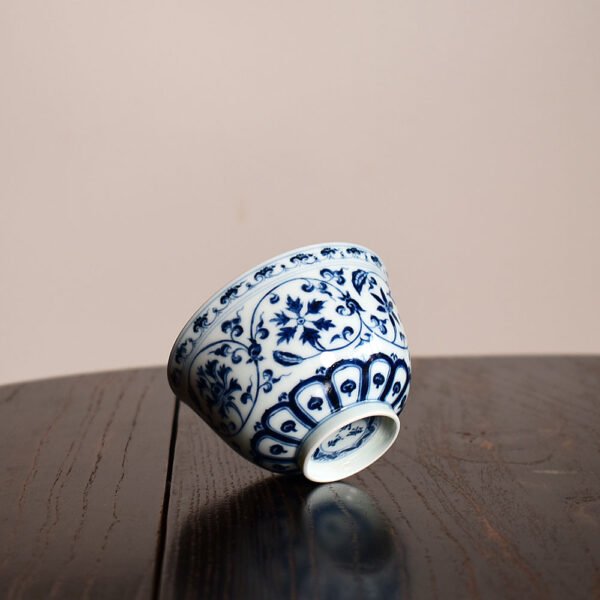 $515.99
$515.99The style of this super beautiful teacup is Ming, using the underglaze blue technique, and entirely handcrafted and hand painted. The pattern features the classic design of intertwining lotus branches (Chanzhi Lian).
Chanzhi Lian, also known as ‘intertwining lotus branches’ or ‘Interlock Branch Lotus’, is a Chinese decorative motif with the symbolism of “flowers within flowers, blossoms within leaves.” It is also referred to as the “Wanshou Teng,” representing auspiciousness and longevity due to its continuous and interconnected structure, symbolizing the concept of “endless vitality.” In addition, in traditional Chinese Confucian culture, the lotus is seen as the embodiment of truth, goodness, and beauty, as well as a symbol of Buddhism. The pronunciation of “Lian” is similar to the word “continuous” in Chinese, further expressing the idea of continuous growth and conveying positive wishes and emotions.
As part of Chinese traditional ornamentation, Chanzhi Lian has been passed down through generations, reflecting its own beauty and cultural significance with a unique artistic charm. The lotus possesses a sacred and pure temperament, being beautiful without being ostentatious and magnificent without being vulgar. It is precisely because of this aesthetic appeal that Chanzhi Lian has become a decorative pattern applied to various aspects of life.
In addition, the beautiful tin spots on the porcelain add even more unique charm to it. The formation of tin spots is due to the high content of iron elements in local parts of the blue pigment. After reaching saturation in the high-temperature glaze solution and cooling down, the iron elements in the supersaturated part start to precipitate. If the iron content of the blue pigment is higher and the cooling rate is appropriate, tin spots are more likely to appear on the surface of the ware.
In addition to firing and materials, the formation of tin spots also involves the factor of glaze material. During the painting process, tin spots can also be formed due to the accumulation of blue pigment. Tin spots are more likely to appear on the surface of the ware at the intersections and the starting and ending points of brushstrokes. The formation of tin spots can be said to be a natural creation or an artificial decoration. This tin glazes not only add a rustic texture to the teacup but also imbue it with a unique sense of history.
The delicate brushstrokes and intricate detailing of the painting on this teacup create a distinct sense of aesthetic appeal. The soft and elegant shade of underglaze blue, along with a hint of faint tin glaze, gives it a graceful and ethereal beauty under the light. This teacup exudes a simple yet elegant charm, reminiscent of the style of imitation Ming, making it truly captivating and irresistible.
-
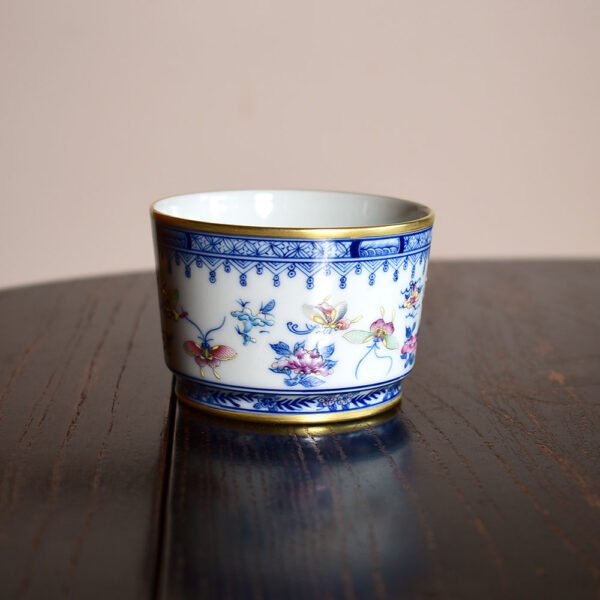
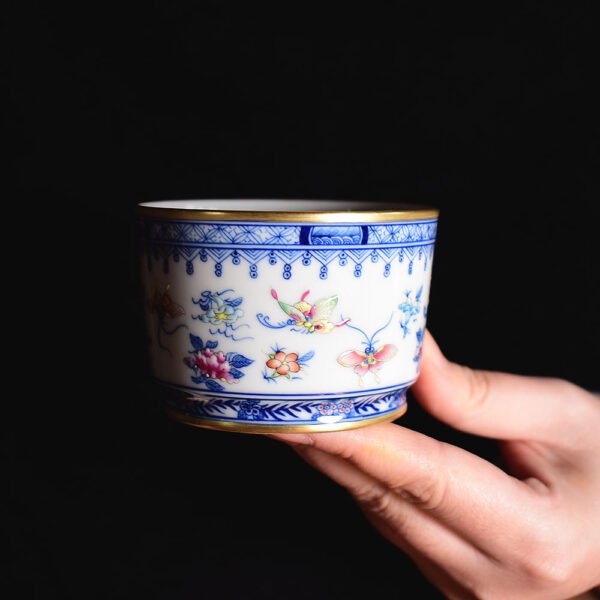 $588.99
$588.99This master cup is handcrafted using the technique of gold painting, Blue-and-white underglaze colour and enamel glazed and painted. The design features a pattern of butterflies amid flowers, displaying rich and lifelike colours, creating a unique and charming ambiance.
Gold painting, one of the decorative techniques, involves applying gold powder (gold dust) or bright gold (gold solution) on the porcelain surface to create intricate patterns or to complement other decorations as borders or a golden background. Afterward, the cup is fired at a low temperature to achieve the final finish. Both the rim of this teacup’s mouth and bottom base employ the gold painting technique.
Blue and White Enamel is a distinctive porcelain decoration technique that combines the traditional methods of blue and white with enamel. It is a variation of traditional Chinese porcelain production, blending the characteristics of blue and white with enamel, resulting in a captivating and unique decorative style.
Blue and White refers to the technique of painting blue patterns on a porcelain surface. It originated during the Yuan dynasty but reached its peak during the Ming and Qing dynasties. This decorative method uses cobalt oxide blue pigments that fuse with the porcelain surface at high temperatures, ensuring the patterns’ durability.
Enamel, on the other hand, is a decorative technique that involves transplanting the cloisonné enamel method onto a porcelain body as an overglaze colour decoration. Enamel decoration on porcelain, known as “Fàlángcǎi” in Chinese, entails painting colourful patterns on the porcelain surface and then firing it at high temperatures to fuse the colours with the porcelain, achieving a durable and splendid design. These patterns often feature exquisite themes such as flowers, birds, figures, and landscapes, reflecting the essence of traditional Chinese culture and art.
The process of creating enamel decorations is extremely intricate and complex, requiring skilled and experienced craftsmen. First, the porcelain prototype is made, and then special mineral pigments are used to paint patterns on its surface. Once the painting is completed, a series of firing processes follow, during which the temperature and timing for both the porcelain and the enamel colours are crucial factors. Improper temperature or timing can result in cracks in the porcelain or unstable colours. Enamel decoration is considered a treasure in traditional Chinese craftsmanship, representing the wisdom and skills of ancient Chinese artisans.
The combination of blue and white enamel unites these two techniques, typically starting with the blue and white technique to depict blue patterns, and then applying enamel decoration to add additional colours and enhance the visual effect and three-dimensional sense of the design. This decorative method enriches the patterns on the porcelain while preserving the distinctive features of both blue and white and enamel techniques. During the Ming and Qing dynasties, blue and white enamel reached its peak and became one of the main styles for porcelain decoration at that time.
The design on this master teacup showcases lifelike patterns of butterflies amid flowers. “Butterflies in Love with Flowers” symbolize sweet love and blissful marriage. In recent times, people have endowed this motif with more profound meanings, expressing good wishes and symbolizing beautiful and prosperous love. Butterflies are often seen as symbols of happiness and love, inspiring and captivating people’s imagination, and aspirations. In traditional Chinese literature, a pair of flying butterflies represents the pursuit of free and passionate love. Butterflies are loyal to their mates, having only one partner throughout their lives, making them a symbol of fidelity in the insect world. Moreover, there is a beautiful Chinese folktale known as “The Butterfly Lovers,” which further enhances the symbolism of sweet love and harmonious marriage associated with the motif of butterflies and flowers.
This enamel-decorated master cup displays a rich and colourful palette, with lively and dynamic brushstrokes, immersing people in an elegant artistic ambiance while enjoying their tea.
-
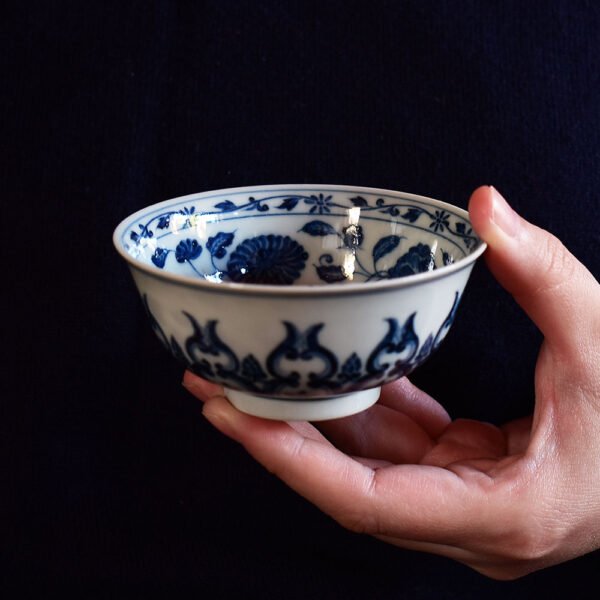
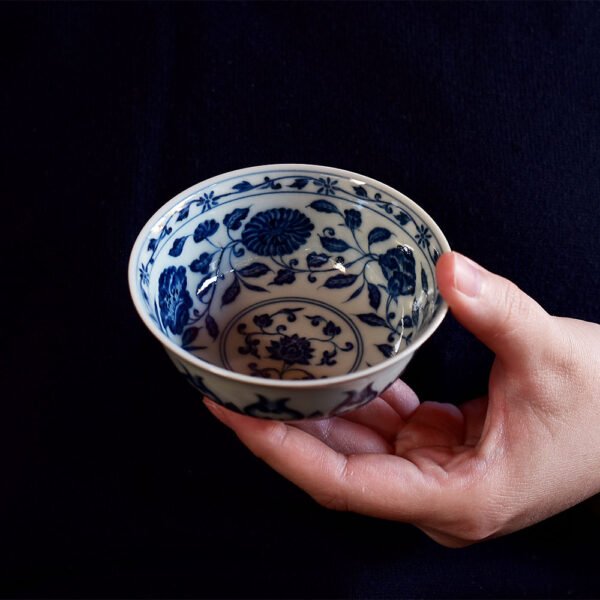 $645.99
$645.99The style of this super beautiful teacup is Ming, using the underglaze blue technique, and entirely handcrafted and hand painted. The pattern on the body of the teacup showcases the traditional Chinese twin lotus motif.
In addition, the beautiful tin spots on the porcelain add even more unique charm to it. The formation of tin spots is due to the high content of iron elements in local parts of the blue pigment. After reaching saturation in the high-temperature glaze solution and cooling down, the iron elements in the supersaturated part start to precipitate. If the iron content of the blue pigment is higher and the cooling rate is appropriate, tin spots are more likely to appear on the surface of the ware.
In addition to firing and materials, the formation of tin spots also involves the factor of glaze material. During the painting process, tin spots can also be formed due to the accumulation of blue pigment. Tin spots are more likely to appear on the surface of the ware at the intersections and the starting and ending points of brushstrokes. The formation of tin spots can be said to be a natural creation or an artificial decoration. This tin glazes not only add a rustic texture to the teacup but also imbue it with a unique sense of history.
The delicate brushstrokes and intricate detailing of the painting on this teacup create a distinct sense of aesthetic appeal. The soft and elegant shade of underglaze blue, along with a hint of faint tin glaze, gives it a graceful and ethereal beauty under the light. This teacup exudes a simple yet elegant charm, reminiscent of the style of imitation Ming, making it truly captivating and irresistible.
-
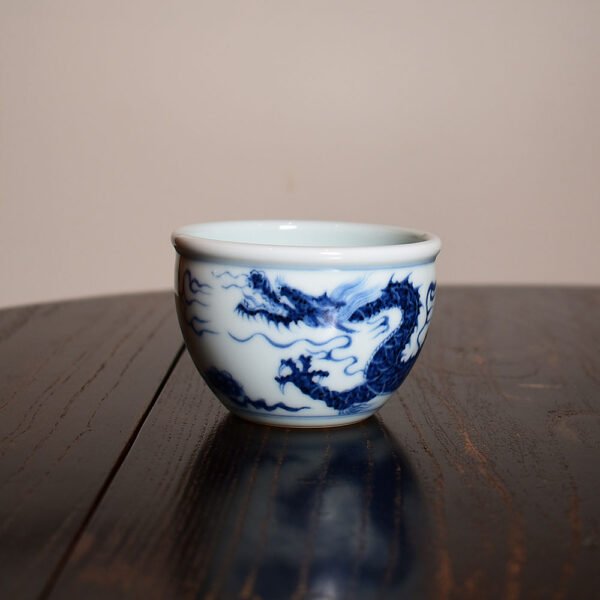
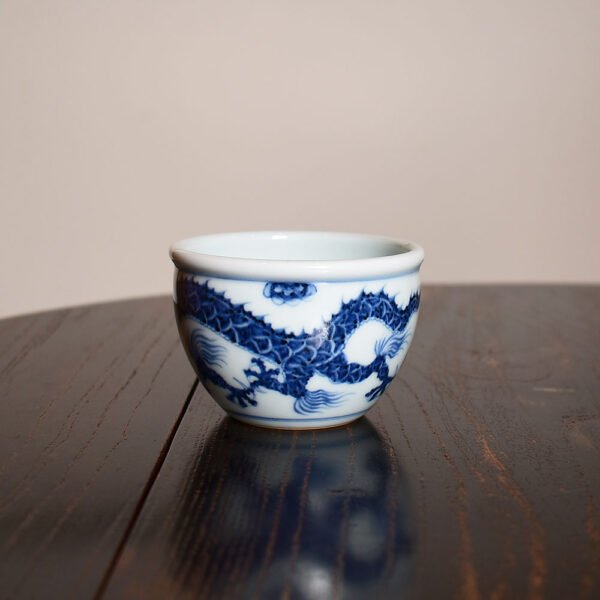 $439.99
$439.99This master teacup is made in the style of the Yuan dynasty blue and white porcelain, completely handmade and hand-painted. The entire painting exudes a strong sense of antiquity, with bold and vigorous lines, and the dragon pattern appears vivid and lifelike.
In Chinese culture, the dragon is a very important symbol and totem with rich symbolism. Firstly, the dragon is one of the most sacred, authoritative, and noble images in ancient Chinese culture. It is the incarnation of the gods of heaven, earth, and water, representing supreme authority and divine power. Secondly, the dragon is considered a symbol of good luck in Chinese culture. As it has the special power to control rainfall, it is also seen as the protector of agriculture, representing a bountiful harvest and prosperity. Additionally, the dragon has many other symbolic meanings, such as longevity, authority, success, courage, and wisdom. In traditional Chinese culture, the dragon is a noble, mysterious, and awe-inspiring image, representing people’s yearning for the unknown and the spirit of exploration.
Besides, for Yuan blue and white porcelain refers to the blue and white porcelain produced during the Yuan dynasty (1271-1368) in China. The Yuan dynasty was an important period in the history of Chinese porcelain and one of the peaks of Chinese porcelain art. As one of the representatives of that era, Yuan blue and white porcelain exhibited unique artistic styles and technical levels. The characteristic of Yuan blue and white is the use of cobalt blue pigment for painting, which is made of cobalt oxide. After firing, the colour is bright and rich, with an extremely high decorative effect. Yuan blue and white porcelain has various shapes, thick and heavy, concise, and fluent lines, and stable and solemn shapes, all made exquisitely.
The evolution of Yuan blue and white is based on the foundation of the Tang and Song celadon. Firstly, the glaze colour was improved and innovated. Unique white glaze, eggshell glaze, and blue-white glaze were invented to make the glaze crystal clear. Cobalt pigment was imported for glaze colouring. Or using pigment made from domestic materials.
The formation of tin spots on Yuan blue and white is due to the high content of iron elements in local parts of the blue pigment. After reaching saturation in the high-temperature glaze solution and cooling down, the iron elements in the supersaturated part start to precipitate. If the iron content of the blue pigment is higher and the cooling rate is appropriate, tin spots are more likely to appear on the surface of the ware.
In addition to firing and materials, the formation of tin spots also involves the factor of glaze material. During the painting process, tin spots can also be formed due to the accumulation of blue pigment. Tin spots are more likely to appear on the surface of the ware at the intersections and the starting and ending points of brushstrokes. The formation of tin spots can be said to be a natural creation or an artificial decoration.
This master teacup has a smooth and lustrous texture and uses the Su Ma Li Qing glaze material (a kind of blue pigment), with a heavy sense of tin spots, revealing a unique charm of the past era. The entire production process is completed by hand, and every detail has been carefully designed and polished, giving this teacup a unique artistic charm. The blue and white dragon pattern is vivid, showcasing ancient cultural and aesthetic values, allowing people to immerse themselves in a beautiful artistic atmosphere while enjoying their tea.
-
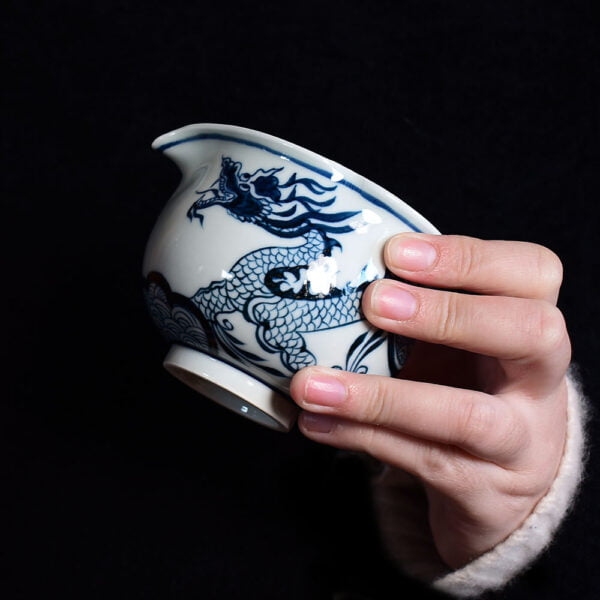
 Out of Stock
$195.99
Out of Stock
$195.99In Chinese culture, the dragon is a very important symbol and totem with rich symbolism. Firstly, the dragon is one of the most sacred, authoritative, and noble images in ancient Chinese culture. It is the incarnation of the gods of heaven, earth, and water, representing supreme authority and divine power. Secondly, the dragon is considered a symbol of good luck in Chinese culture. As it has the special power to control rainfall, it is also seen as the protector of agriculture, representing a bountiful harvest and prosperity. Additionally, the dragon has many other symbolic meanings, such as longevity, authority, success, courage, and wisdom. In traditional Chinese culture, the dragon is a noble, mysterious, and awe-inspiring image, representing people’s yearning for the unknown and the spirit of exploration.
This fair cup is made in the style of the Yuan dynasty blue and white porcelain, completely handmade and hand-painted. The blue and white dragon pattern is vivid, showcasing ancient cultural and aesthetic values, allowing people to immerse themselves in a beautiful artistic atmosphere while enjoying their tea.
For Yuan blue and white porcelain refers to the blue and white porcelain produced during the Yuan dynasty (1271-1368) in China. The Yuan dynasty was an important period in the history of Chinese porcelain and one of the peaks of Chinese porcelain art. As one of the representatives of that era, Yuan blue and white porcelain exhibited unique artistic styles and technical levels. The characteristic of Yuan blue and white is the use of cobalt blue pigment for painting, which is made of cobalt oxide. After firing, the colour is bright and rich, with an extremely high decorative effect. Yuan blue and white porcelain has various shapes, thick and heavy, concise, and fluent lines, and stable and solemn shapes, all made exquisitely.
The evolution of Yuan blue and white is based on the foundation of the Tang and Song celadon. Firstly, the glaze colour was improved and innovated. Unique white glaze, eggshell glaze, and blue-white glaze were invented to make the glaze crystal clear. Cobalt pigment was imported for glaze colouring. Or using pigment made from domestic materials.
The formation of tin spots on Yuan blue and white is due to the high content of iron elements in local parts of the blue pigment. After reaching saturation in the high-temperature glaze solution and cooling down, the iron elements in the supersaturated part start to precipitate. If the iron content of the blue pigment is higher and the cooling rate is appropriate, tin spots are more likely to appear on the surface of the ware.
In addition to firing and materials, the formation of tin spots also involves the factor of glaze material. During the painting process, tin spots can also be formed due to the accumulation of blue pigment. Tin spots are more likely to appear on the surface of the ware at the intersections and the starting and ending points of brushstrokes. The formation of tin spots can be said to be a natural creation or an artificial decoration.
This fair cup has a thick body and uses the Su Ma Li Qing glaze material (a kind of blue pigment), with a heavy sense of tin spots, revealing a unique charm of the past era. The entire production process is completed by hand, and every detail has been carefully designed and polished, giving this teacup a unique artistic charm. The blue and white dragon pattern is vivid, showcasing ancient cultural and aesthetic values, allowing people to immerse themselves in a beautiful artistic atmosphere while enjoying their tea.
-
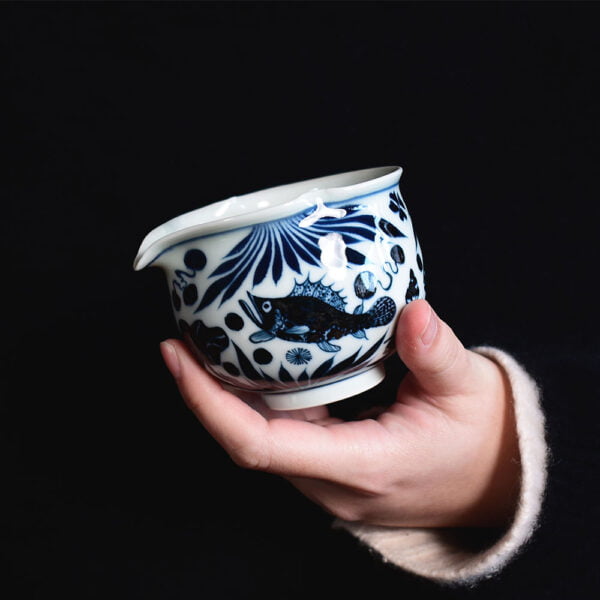
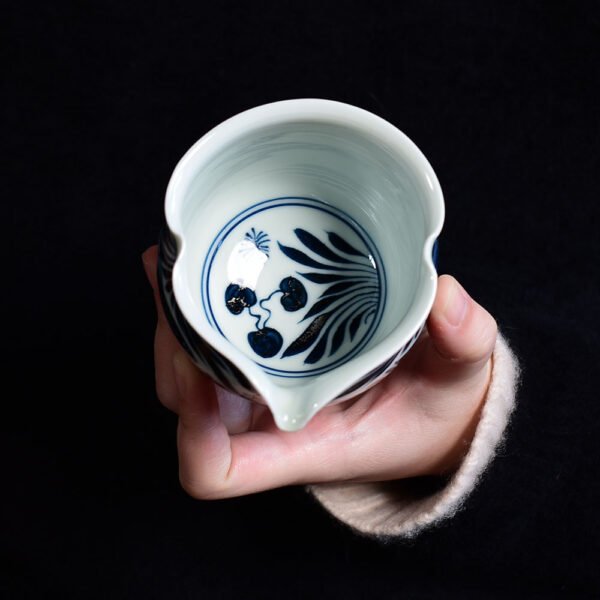 Out of Stock
$195.99
Out of Stock
$195.99This fair cup is made in the style of the Yuan dynasty blue and white porcelain, completely handmade and hand-painted. The blue and white fish & seaweed pattern is vivid, showcasing ancient cultural and aesthetic values, allowing people to immerse themselves in a beautiful artistic atmosphere while enjoying their tea.
The special pattern of this teacup is fish and seaweed. Since ancient times, fish and seaweed motifs have been traditional decorative patterns in ceramics, representing auspiciousness and carrying rich cultural and aesthetic meanings. The homophonic association between fish and the Chinese word for “surplus” (yu) makes fish a symbol of abundance and wealth. Fish motifs are often used to convey the meaning of “abundance and surplus,” “prosperity year after year” (as the pronunciation of fish is similar to that of “surplus” in Chinese), and “auspicious celebrations and abundance.” The fish and seaweed motifs typically feature fish as the central element, with additional decorations such as water plants, forming a variety of decorative patterns. The depiction of four swimming fish in the artwork symbolizes the concept of “surplus in all four seasons,” representing a year-round surplus, which carries a highly positive connotation. Such motifs are not only favoured by the royal court but also beloved by people from all walks of life as auspicious decorations. The flexible composition, auspicious symbolism, and abundant variations of fish and seaweed motifs have made them timeless classics throughout different eras.
For Yuan blue and white porcelain refers to the blue and white porcelain produced during the Yuan dynasty (1271-1368) in China. The Yuan dynasty was an important period in the history of Chinese porcelain and one of the peaks of Chinese porcelain art. As one of the representatives of that era, Yuan blue and white porcelain exhibited unique artistic styles and technical levels. The characteristic of Yuan blue and white is the use of cobalt blue pigment for painting, which is made of cobalt oxide. After firing, the colour is bright and rich, with an extremely high decorative effect. Yuan blue and white porcelain has various shapes, thick and heavy, concise, and fluent lines, and stable and solemn shapes, all made exquisitely.
The evolution of Yuan blue and white is based on the foundation of the Tang and Song celadon. Firstly, the glaze colour was improved and innovated. Unique white glaze, eggshell glaze and blue-white glaze were invented to make the glaze crystal clear. Cobalt pigment was imported for glaze colouring. Or using pigment made from domestic materials.
The formation of tin spots on Yuan blue and white is due to the high content of iron elements in local parts of the blue pigment. After reaching saturation in the high-temperature glaze solution and cooling down, the iron elements in the supersaturated part start to precipitate. If the iron content of the blue pigment is higher and the cooling rate is appropriate, tin spots are more likely to appear on the surface of the ware.
In addition to firing and materials, the formation of tin spots also involves the factor of glaze material. During the painting process, tin spots can also be formed due to the accumulation of blue pigment. Tin spots are more likely to appear on the surface of the ware at the intersections and the starting and ending points of brushstrokes. The formation of tin spots can be said to be a natural creation or an artificial decoration.
This fair cup has a thick body and uses the Su Ma Li Qing glaze material (a kind of blue pigment), with a heavy sense of tin spots, revealing a unique charm of the past era. The entire production process is completed by hand, and every detail has been carefully designed and polished, giving this teacup a unique artistic charm. The blue and white fish & seaweed pattern is vivid, showcasing ancient cultural and aesthetic values, allowing people to immerse themselves in a beautiful artistic atmosphere while enjoying their tea.
-
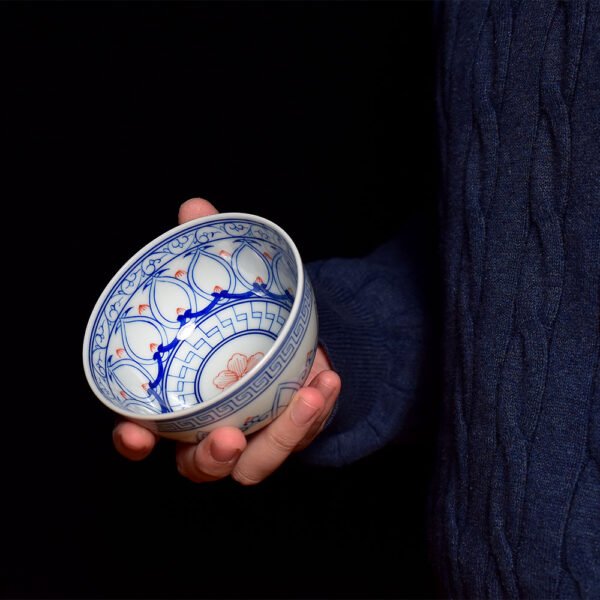
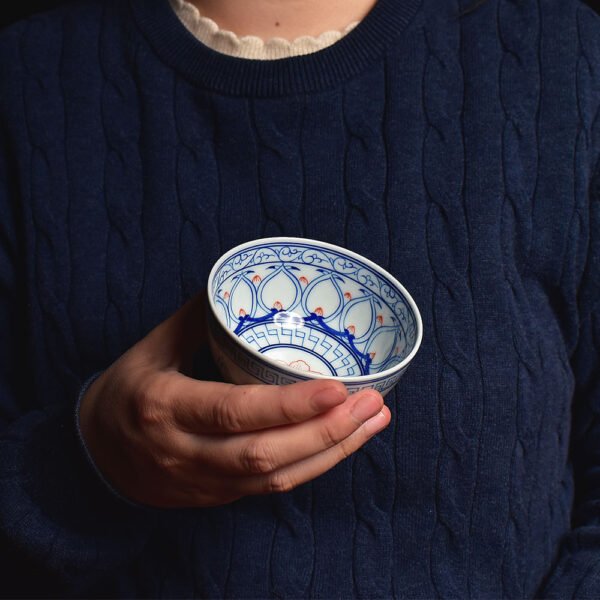 $189.99
$189.99This heart shaped teacup is completely handmade, and hand painted. The special craft used in this teaware includes Blue and white underglaze colour and underglaze red.
The pattern featured is called “Bao Xiang” in Chinese, which is a traditional decorative motif representing one of the auspicious three treasures (Bao Xiang flower, Money tree, and Treasure basin), prevalent during the Sui and Tang dynasties in China. Bao Xiang pattern is also known as ‘Bao Xian Hua’ or ‘Bao Lian Hua’. Its lines are clear, and the colour is serene and antique. The Bao Xiang pattern design of this teaware is neat, and complex but not messy, and the whole picture of it is full and rich in details.
In Chinese culture, the Bao Xiang pattern symbolizes auspiciousness and happiness, representing people’s aspirations for happiness. It is widely popular in the decoration of silk brocade, bronze mirrors, and porcelain, showcasing people’s pursuit of a better life.
This heart shaped teacup features smooth and concise curves, combining the unique beauty of Bao Xiang pattern, creating a visually appealing and enjoyable tea-drinking experience. The blue and red underglaze colours complement each other and create a beautiful radiance.
-
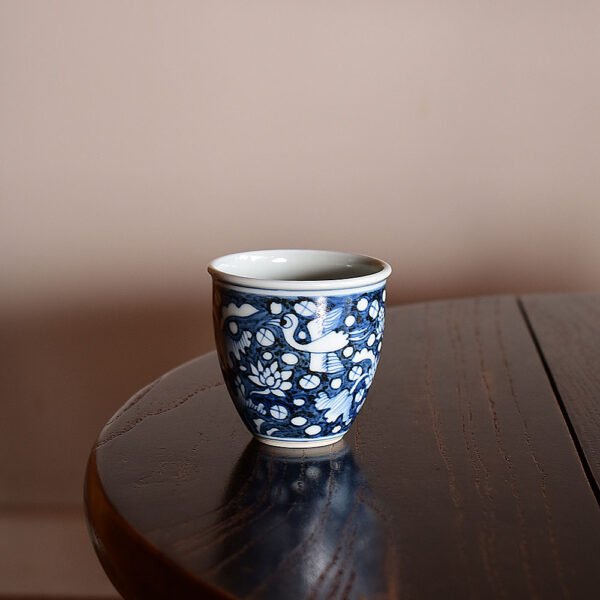
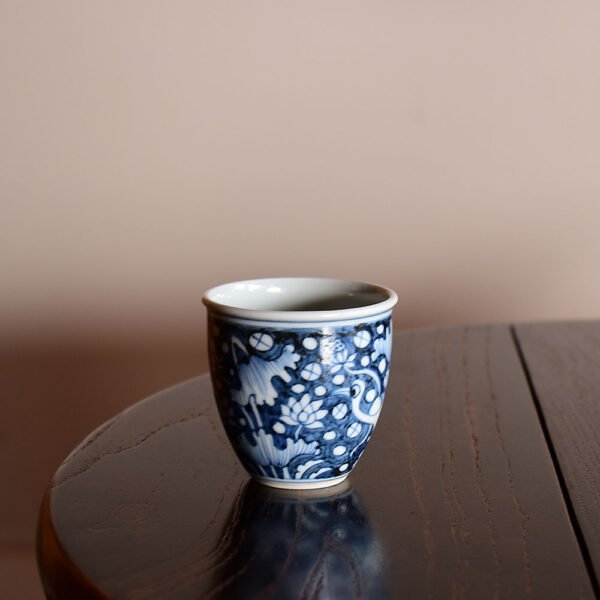 $279.99
$279.99This teacup is made in the style of the Yuan dynasty blue and white porcelain, matt glaze finish, completely handmade and hand painted. The pattern of “一鹭莲科” or “一路连科” in Chinese culture is derived from the beautiful combination of the heron and lotus leaves. As “鹭” (heron) and “路” (path/road) have the same pronunciation, and “莲” (lotus) sounds like “连” (successive/continuous), the name “一路连科” is a play on words that conveys the beautiful meaning of the pattern. In ancient times, successive successful candidates in the imperial examinations were called “连科,” and “一路连科” is a good wish for students to have a smooth career path and achieve success step by step.
For Yuan blue and white porcelain refers to the blue and white porcelain produced during the Yuan dynasty (1271-1368) in China. The Yuan dynasty was an important period in the history of Chinese porcelain and one of the peaks of Chinese porcelain art. As one of the representatives of that era, Yuan blue and white porcelain exhibited unique artistic styles and technical levels. The characteristic of Yuan blue and white is the use of cobalt blue pigment for painting, which is made of cobalt oxide. After firing, the colour is bright and rich, with extremely high decorative effect. Yuan blue and white porcelain has various shapes, thick and heavy, concise, and fluent lines, and stable and solemn shapes, all made exquisitely.
The evolution of Yuan blue and white is based on the foundation of Tang and Song celadon. Firstly, the glaze colour was improved and innovated. Unique white glaze, eggshell glaze and blue-white glaze were invented to make the glaze crystal clear. Cobalt pigment was imported for glaze colouring. Or using pigment made from domestic materials.
The formation of tin spots on Yuan blue and white is due to the high content of iron elements in local parts of the blue pigment. After reaching saturation in the high-temperature glaze solution and cooling down, the iron elements in the supersaturated part start to precipitate. If the iron content of the blue pigment is higher and the cooling rate is appropriate, tin spots are more likely to appear on the surface of the ware.
In addition to firing and materials, the formation of tin spots also involves the factor of glaze material. During the painting process, tin spots can also be formed due to the accumulation of blue pigment. Tin spots are more likely to appear on the surface of the ware at the intersections and the starting and ending points of brushstrokes. The formation of tin spots can be said to be a natural creation or an artificial decoration.
This teacup is small and exquisite and uses the Su Ma Li Qing glaze material (a kind of blue pigment), with a heavy sense of tin spots, revealing a unique charm of the past era. The entire production process is completed by hand, and every detail has been carefully designed and polished, giving this teacup a unique artistic charm.
-
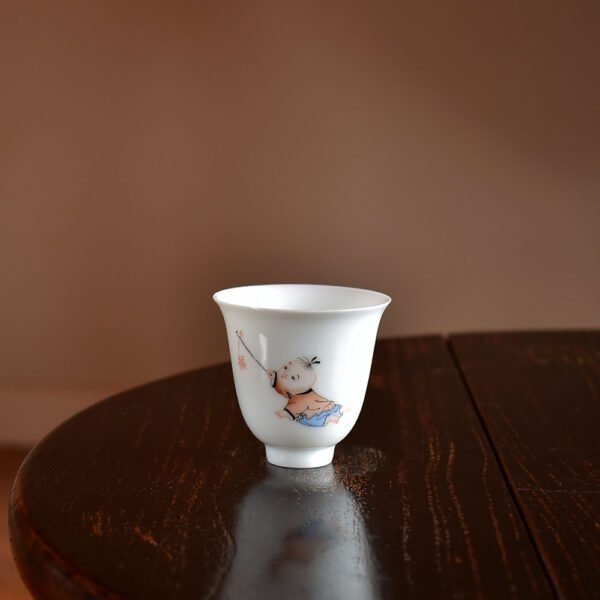
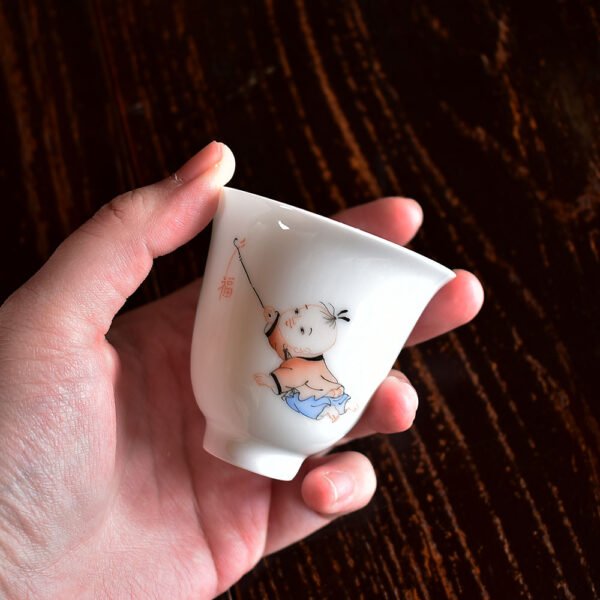 $45.99
$45.99The teacup is made from high-quality white mud, giving it a smooth and elegant texture. The surface is covered in a lovely white glaze, which creates a beautiful and glossy finish. The cup is adorned with overglaze colours in two different patterns.
One of the patterns depicts children setting off firecrackers, a symbol of celebration and joy in Chinese culture. The other pattern shows a child with good fortune, representing prosperity and good luck. Both patterns are intricate and detailed, featuring vibrant colours that contrast beautifully against the white background.
Due to being entirely hand-painted, each painting has slight differences.




